Grandma Ella's Mandelbrot
08/10/2020 08:57:21 AM
Linda Berman
| Author | |
| Date Added |
Grandma Ella’s Original Mandelbrot
- 1 cup butter
- 1 Tablespoon baking powder
- 12 ounces toasted almond slivers
- 1 cup sugar
- ¼ teaspoon salt
- ½ cup cinnamon sugar mixture
- 4 eggs
- 1 teaspoon vanilla or almond extract
- 4 cups flour
- Heat oven to 350 degrees
- Put parchment paper on a large cookie sheet.
- Cream butter and sugar.
- Add eggs, flour, baking powder, salt, and vanilla .
- Add toasted almonds.
- Mix well.
- Make 4-5 loaves out of dough- each should be: 2”wide x 1” high
- Sprinkle cinnamon sugar mixture over the top.
- Bake 25-30 minutes until light brown.
- Slice the loaves into pieces.
- Turn the pieces on their side.
- Sprinkle with cinnamon sugar mixture.
- Bake 10 minutes
- Turn the pieces on their other side.
- Sprinkle with cinnamon sugar mixture.
- Bake 10 more minutes.
- Cool.
Mandel Bread Recipe Variation from Grandma Ella Wagner
- 1 cup butter
- 1 Tablespoon baking powder
- 1 cup sugar
- ¼ teaspoon salt
- 4 eggs
- 1 teaspoon vanilla
- 4 cups flour
- 12 ounce bag chocolate chips (optional)
- Cinnamon sugar mixture (About ½ cup sugar and 2 T cinnamon)
- Pre-heat oven to 350°.
- Grease or parchment paper 2 large cookie sheets.
- Mix ingredients (except the cinnamon sugar mixture) to make 4 loaves -- 2”wide x 1”high and as long as the cookie sheet.
- Place loaf on cookie sheet and sprinkle the cinnamon sugar mixture on the top of the loaves.
- Bake for 25-30 minutes until the loaves are brown on the top and bottom.
- Cool slightly and then slice the loaves. Put the pieces on their side. Sprinkle the cinnamon sugar on that side. Bake for another 10 minutes.
- Turn the pieces onto their other side. Sprinkle with the cinnamon sugar mixture. Bake another 10 minutes.
- Carefully place on cooling racks.
Volunteer Opportunities
08/02/2020 10:20:22 PM
| Author | |
| Date Added |
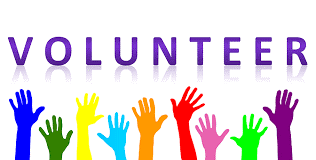
Volunteering is not as easy these days as it used to be, but there are still things you can do to help people in our community.
Catholic Multicultural Center
The Catholic Multicultural Center (CMC) meal program continues to provide grab-and-go meals from the CMC parking lot. Our volunteers drop off food every other Wednesday to meet the growing need. We cook for 80+ people by sharing recipes and dividing up the work. If you are interested in preparing food at home for delivery to CMC, please use the SignUpGenius link. Contact Sue Levy if you have any questions.
Porchlight
Porchlight has opened two shelters to provide more housing and to separate men who are ill from those who are healthy. They are in need of volunteers to do nightly health assessments at the Warner Park men’s shelter, from 5:00 pm to 8:00 pm at 1625 Northport Drive. If interested, please email Kim Sutter.
Healing House
Healing House serves individuals without homes as they recuperate from surgery, illness, or childbirth. TBE cooks meals for the residents and staff on a quarterly basis. We have enough volunteers for the August rotation.
Healing House is also seeking volunteers to work in the house supporting the families who stay there. Volunteers assist with childcare, preparing meals, cleaning rooms, and supporting staff as needed. There is no type of “normal” day, as it depends on the makeup of the guests. The ideal Healing House volunteer will be consistent, flexible, motivated, and caring. Volunteers commit to at least two four-hour shifts a month, for at least six months. Shifts are offered 7:00 am–11:00 pm, seven days a week.
Thoreau and Emerson Elementary Schools
The Madison Metropolitan School District has announced that children will not be returning to the physical classroom until at least early November. This presents a difficult situation for many families whose food budget stretches further when their children can get two meals a day at school. We can support these families by volunteering with or donating to their partner agency, Second Harvest Foodbank of Southern Wisconsin. Sign up here to volunteer and here to donate. For Thoreau School, no decisions have been made yet about additional ways to provide food to families at home.
Emerson School is not likely to use literacy and math mentors for the foreseeable future. The principal has sent a couple of suggestions for how we can continue to support the school:
- Use Amazon Smile when you shop Amazon. Add Emerson Elementary PTO (Madison, WI) as your charity. This costs participants nothing.
- Download the BoxTops apps on your phone. Add Emerson Elementary (searching for zip code 53704 is fastest). Follow the directions—basically, take a picture of your grocery receipts—and anything that is a BoxTops brand will be counted. Also free.
- If you are feeling generous, support the school’s current GoFundMe for purchase of new smartboards.
United Way Volunteer Center
United Way of Dane County has compiled a list of volunteer opportunities specifically needed during the pandemic. They are currently looking for website managers, food bank warehouse workers, food pantry gardeners, sweet corn harvesters, blood drive volunteers, and a wide variety of other positions. Many of the volunteer jobs can be done using social distancing or from home.
Undocumented Immigrants Face Dangerous Conditions in Detention
08/02/2020 10:16:54 PM
by Lynn Silverman, Erica Serlin, and Marta Karlov
| Author | |
| Date Added |
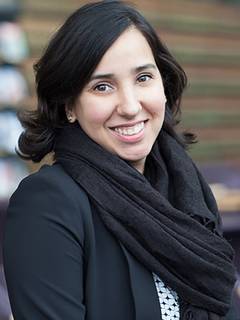
On June 22, 2020, the Temple Beth El Immigrant Rights Action Team co-sponsored an educational presentation and advocacy action request with Dane Sanctuary Coalition about the impact of COVID-19 on undocumented immigrants. This event was open to all Temple Beth El congregants and Dane Sanctuary Coalition member congregations through a live Zoom event.
This presentation was tied to our receipt of a $1,500 mini-grant award from the Gilbert and Eleanor Krause Initiative for Immigrant and Refugee Justice at the Religious Action Center (RAC). We used this grant to partner with the Community Immigration Law Center (CILC) to provide education to CILC’s attorneys to enhance the legal representation they provide to immigrants facing deportation. Aissa Olivarez, managing attorney for CILC, described the trainings and then spoke about the status of immigrants in detention and the impact of COVID-19 on these immigrants.
Ms. Olivarez noted that there are currently 50,000 immigrants in detention nationwide, more people detained than in the previous 150 years. Because of expanded priorities under the current administration, people convicted of any offense, no matter how minor, or even just charged with an offense, can be detained. Vulnerable populations, such as pregnant women, parents with young children, and mentally ill people, are no longer protected. Detainees include individuals who have overstayed their visas and those awaiting court decisions on removal, including people seeking asylum from violence and persecution. All of this detracts attention from those who actually pose a safety risk.
Conditions in detention have been dangerous for years. There have been 193 deaths of people in ICE custody since 2004. Now with COVID-19, the risk is even more pronounced and the conditions even more dire. The detention centers have no capacity for social distancing, do not provide adequate protection, and have limited medical care. For this reason, the RAC, the Union for Reform Judaism’s social justice arm, has been advocating for immediate release of detainees to sponsors and family members.
In addition, our program included brief presentations by two local nonprofits that provide advocacy for the Latinx community, Worker Justice Wisconsin and Voces de la Frontera. They spoke about their efforts to promote safe return-to-work environments for low-wage and undocumented workers in the age of COVID-19.
Our presentation concluded with several suggestions for action steps, including donating to local organizations supporting undocumented immigrants, such as Dane County Immigrant Assistance Fund, voting and working on get-out-the-vote campaigns, and writing to legislators to ask them to release all people held in detention and to stop deportations. A sample letter from the Interfaith Immigration Coalition Toolkit was included for participants.
Pride Month Celebrations
08/02/2020 10:06:36 PM
By Paul Grossberg and Aleeza Hoffert
| Author | |
| Date Added |
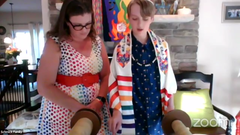
Temple Beth El wove together a beautiful tapestry of Jewish values, tikkun olam, inclusion, diversity, immigration, and racial justice during PRIDE month in June. By celebrating LGBTQ people and values within our Temple and larger communities, we all felt valued, uplifted, informed, and motivated to help improve our world. We did this through many varied and engaging programs.
We decorated our digital world with rainbows, we filled our souls with music by LGBTQ composers and themes sung by Cantor Jacob Niemi each week, we added color to the recipes featured in our Quarantine Kitchen program (including two youth bakers), we learned with Rena Yehuda Newman about Queer Jewish Memory and with Cantor Niemi on looking at Jewish texts with a “bent lens,” we celebrated a spirited pride Shabbat, and we even learned how to make a few different Pride-themed friendship bracelets.
Rena Yehuda Newman’s Zoom meeting on Queer Jewish Memory was fascinating and provided a powerful message about “expanding the archives” and documenting personal stories to ensure that future historians have a complete picture. For example, Newman’s research showed that the history of the late-1960s Black student strike at UW reveals documents and perspectives of university administrators but few if any documents or perspectives from the Black students themselves. They challenged us to question what we would document and put in an archive to capture LGBTQ lives and struggles and what we want remembered, and to reach out to archives to do just that. What are we contributing to Queer Jewish memory?
Cantor Niemi’s insightful "bent lens” journey through Jewish texts was truly thought-provoking, depicting differing interpretations of texts through the ages. Cantor Niemi explained how the rabbis learned how to deal with gender fluidity and sexual differences because of the ancient Jewish tradition of having people bring questions and difficulties to the rabbis for advice and wisdom. While traditional norms may be continually reinforced through the centuries, there is ample evidence that Judaism has accepted and even embraced these differences.
Pride Shabbat was a beautiful service filled with meaningful prayers and heartwarming music from specially selected composers. We so appreciate our rabbi’s and cantor’s wisdom, caring messages and words, and inclusive support for all of us in our community.
The Pride committee also put together a wonderful list of resources that can be found on the
Temple blog.
You can continue to feel the Pride by watching these recordings:
Pride Friendship bracelets (click here for instructions)
Quarantine Kitchen Pride Edition—Rainbow Challah with Jen Szlasa (click here for recipe)
Quarantine Kitchen Pride Edition—Pride Flag Cupcakes with Theo Jacobsohn (click here for recipe)
Quarantine Kitchen Pride Edition—Rainbow Cheesecake Swirl Bars with Eliana Goff (click here for recipe)
Bo’u Nashir (“Come, Let Us Sing”) – June 2, 2020
Bo’u Nashir (“Come, Let Us Sing”) – June 9, 2020
Bo’u Nashir (“Come, Let Us Sing”) – June 16, 2020
Bo’u Nashir (“Come, Let Us Sing”) – June 23, 2020
Bo’u Nashir (“Come, Let Us Sing”) – June 30, 2020
Reclaim Our Vote Campaign: A Virtual Postcard-Writing Party
08/02/2020 10:02:48 PM
| Author | |
| Date Added |
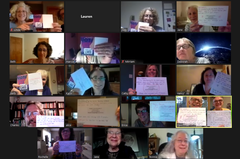
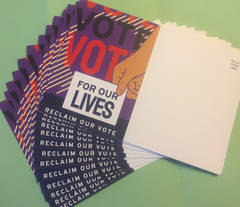
On August 4, the Temple Beth El Civic Engagement Action Team held a postcard-writing project to encourage registration and voting in states that have significant voter suppression laws. The Religious Action Center of Reform Judaism is partnering with the Center for Common Ground in their nonpartisan Reclaim Our Vote campaign, reaching out to eligible voters of color in states where help is most needed. These campaigns have proven to be highly successful in getting unregistered and deregistered voters back on the voting rolls so they may cast their ballots.
Members got together on Zoom to learn more about the campaign, then moved into Zoom “rooms” for casual conversation and company while we added hand-written messages, mailing labels and stamps. It was an easy and fun way to take action from home.
Our MaTTY teens are also excited to be participating in this mitzvah project.
We will hold another postcard party on September 1. Please order your postcard kit through the Union for Reform Judaism by August 11 to participate. We are also planning outreach to voters here in Wisconsin. If you’d like to get involved, please let Aleeza Hoffert know.
Combating Voter Suppression in Wisconsin: Protecting Everyone’s Right to Vote
08/02/2020 09:57:44 PM
| Author | |
| Date Added |
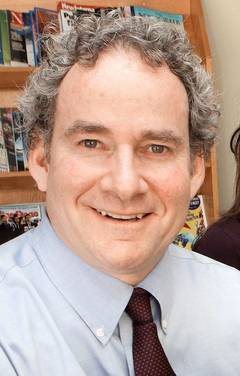
On September 13, Matt Rothschild will discuss the history and current practice of voter suppression in America and in Wisconsin. Matt is the executive director of the Wisconsin Democracy Campaign, which investigates and advocates on issues like gerrymandering, campaign finance, special interest lobbying and electioneering, and voter suppression. The program will conclude with a discussion of what we can do to combat voter suppression and support a healthy democracy.
Prior to joining the Democracy Campaign five years ago, Matt worked at The Progressive magazine for 32 years, most of that time as editor and publisher. His opinion pieces have run in the Chicago Tribune, the LA Times, the Miami Herald, and a host of other newspapers. He has also appeared on Nightline, NPR, C-SPAN, and WISC-TV, where he does election night commentary.
This presentation will be offered by Zoom on Sunday, September 13, 3:00–4:30 pm. The program is sponsored by the Wisconsin Interfaith Voter Engagement Campaign and by Jewish Congregations for Social Justice, a collaborative effort of the social action committees of Temple Beth El, Beth Israel Center, and Congregation Shaarei Shamayim. You can sign up here for the Zoom link.
It is highly recommended that you watch the short 38-minute documentary “Suppressed: The Fight to Vote” before the program. This online video is both engaging and enraging, and will leave you wanting to learn more.
Social Action Shabbat Will Focus on Voting Rights
08/02/2020 09:53:02 PM
| Author | |
| Date Added |
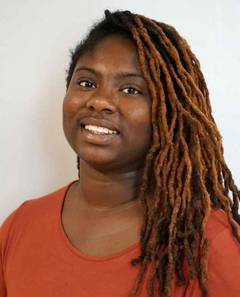
At the Social Action Shabbat on August 28, we will welcome Ryeshia Farmer, coordinator of the “Rights for All” campaign of the ACLU of Wisconsin. Ms. Farmer will talk about the multitude of issues swirling around voting rights, including mail-in ballots, keeping polling places open, voter ID, felon disenfranchisement, disability access, voter roll purges, and more. The TBE Civic Engagement Action Team will offer concrete actions we can take to protect and expand the right to vote for every American.
Throughout the fall, the TBE Civic Engagement Action Team will be working on these issues. At the racial justice conversations in July, many members expressed an interest supporting the efforts of the African American community to increase voter engagement and combat voter suppression. Join us on August 28 on Facebook Live as we learn what we can do to make voting available for all citizens. If you’d like to get involved with our Civic Engagement Action Team, please contact Aleeza Hoffert.
In response to the latest pandemic relief bill, national Jewish organizations urged all U.S. senators to include $3.6 billion in emergency federal funding to help states increase ballot access, which is critical to holding the November 2020 elections fairly and safely during the ongoing COVID-19 public health crisis. The letter stated:
“The right and ability to have a political voice has been crucial to the journey of Jews in this country, and we have always worked to ensure that every eligible voter is able to cast their ballot and have it counted. We are gravely concerned about states’ ability to ensure safe, fair, and accessible elections in the midst of this global pandemic, which is what prompts us to join together to urge the Senate to provide states with the resources they need to execute safe and effective elections.”
At the request of the Social Action Committee, Temple Beth El joined Jewish organizations and synagogues around the country in signing this letter.
Looking Inward, Focusing Outward: An Urgent Conversation on Racial Justice
08/02/2020 09:46:25 PM
by Beth Kaplan
| Author | |
| Date Added |
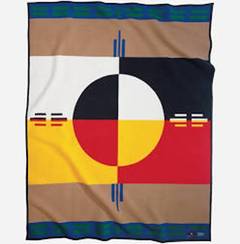
“God formed Adam out of dust from all over the world: yellow clay, white sand, black loam, and red soil. Therefore, no one can declare to any people that they do not belong here since this soil is not their home,” wrote Yalkut Shimoni some 800 years ago.
More than 70 Temple Beth El members participated virtually in “Looking Inward, Focusing Outward: An Urgent Conversation on Racial Justice” in July. Filled with music from Cantor Jacob Niemi and wise words from Rabbi Jonathan Biatch, Rabbi Bonnie Margulis, Racial Justice Action Team Co-Chair Betsy Abramson, and others, the program provided a much-needed opportunity for congregants to listen, learn, share, and plan next steps.
While we may be familiar with the statistics on racial inequities in every area of life here in Madison, in Wisconsin, and in the United States as a whole, seeing them on our computer screens still shocked and disturbed us. As with many things, the enormity of the challenge ahead felt daunting. Hearing about work done by the Religious Action Center and our Temple community showed us that we had a sturdy foundation to build on. Breaking it down into areas we could focus on, and talking about specific steps and actions we could take as individuals and as a congregation, helped all of us feel as if change could indeed happen.
But first, it was so important to listen, to reflect on our own experiences, and to share those stories with each other.
The first to do so was Martye Griffin, who spoke to us in a video he’d recorded to provide the space for us, as white congregants, to talk honestly, without worrying about being judged. An African American member of Temple Beth El, Martye described how his family always dressed up when they went out, and how he had to wear a tie each time. When he asked his mother why his family had to do this while the white families he saw got to dress casually and comfortably, she told him that because people were going to judge them by the color of their skin, they needed to present a picture that was impossible to criticize. He shared other stories about early school days and about college that echoed stories we’ve heard in the weeks since the murder of George Floyd at the hands of police. His stories showed the care and thought that had to go into every action African Americans take on a daily basis to stay safe.
In the virtual equivalent of sitting at tables together in TBE’s Swarsensky Social Hall, we were all placed in different “Zoom rooms” to talk about our own experiences seeing subtle and not-so-subtle examples of racism and inequality around us, as children and as adults. In my “room,” there were stories about experiences where there was no diversity, or where we were the only white people at community celebrations hosted by African American organizations. We shared memories of conversations with family members expressing racist views, or parroting those views as children and being taught profound lessons by parents who set us straight.
I shared a story that still haunts me, about welcoming back my third grade teacher, who was probably the only African American teacher in all of East Brunswick, New Jersey, after a short absence. We adored Mr. O’Kelly, and without him I’d probably never have become an expert on multiplication, one of the few math skills I possess. “Welcome back Aunt Jemima!” I shouted. Mr. O’Kelly looked at me, and quietly asked me why I had said that, why I had called him Aunt Jemima. I remember freezing, knowing I’d said something very wrong, but not being sure what. He gently moved on, but the day General Mills announced recently that they were retiring Aunt Jemima for good, I wished I could write him a note apologizing, more than 50 years later.
From our stories, we moved on to steps we wanted to take going forward. Many in my group were passionate about doing all we could to stop potential voter suppression in the fall elections. Others suggested that as a congregation, we join our community’s African American organizations, faith groups, and others at their life-cycle celebrations, and form coalitions with them to build meaningful relationships. All agreed that we needed to listen hard—and keep listening—to our African American neighbors, and to let those conversations guide us forward.
“It is not your duty to finish the work, but neither are you at liberty to neglect it,” said Rabbi Tarfon. These sessions confirmed that there is much work to do, and a great passion not to neglect that work, no matter the challenges ahead.
-------
The Social Action Committee plans to continue this discussion at our meeting on August 6. One of the clear messages from these conversations is that people are ready to get involved and make a difference. A Zoom invitation will be sent to the Social Action Committee and to those who participated in our racial justice conversations in July. Please contact Aleeza Hoffertif you want to be added to the list.
High Holy Day Food Drive
08/02/2020 09:42:21 PM
| Author | |
| Date Added |

Temple Beth El works year-round to combat hunger through donations and service. One of our signature programs is the High Holy Day Food Drive, which raises thousands of dollars each year for hunger relief. Most of the funds you donate go to Second Harvest Foodbank of Southern Wisconsin, which uses a cost-efficient system to purchase and distribute millions of pounds of food each year.
Last year, we broadened our support to include the Thoreau Elementary weekend food bag program, groceries for the Porchlight shelter program, and the Dane Sanctuary Coalition emergency food fund. With our remaining funds, we made a spring donation to Second Harvest for pandemic hunger relief and summer donations to the Latinx Consortium for Action Emergency Relief Fund, the Mount Zion Baptist Church food pantry, and the Catholic Multicultural Center food pantry.
This year, no surprise, our food drive is going virtual. In the High Holy Days mailing you receive from TBE, you’ll find the familiar food drive envelope. You can make your contribution online here, (choose “High Holy Day Food Drive” as the donation type) or write a check and mail it to the TBE office. Make the check payable to Temple Beth El and include “food drive” on the memo line. You will need to provide a stamp to mail it back in the provided envelope.
Unemployment is high and families suffer as the virus continues to plague our community. Children who are home from school don’t have access to the free-and-reduced breakfast and lunch programs. Food banks and community kitchens have a hard time keeping up with the demand. We hope you will be able to give generously; any amount you can give will be greatly appreciated.
High Holy Days 5781 - Mapping Our Journey Toward Transformation - Step 2: Confession and Personal/Individual Rebuke
07/28/2020 10:01:24 AM
| Author | |
| Date Added |
|
|
|
|
|
|
|
|
|
|
|
|
|
|
|
|
|
|
|
Combating Racism: Resources for Education and Action
07/20/2020 05:12:09 PM
| Author | |
| Date Added |
As people of faith, we are called to love our neighbor as ourselves. Many of us want to take action, but are not always sure what action to take. Wisconsin Faith Voices for Justice has compiled an extensive list of educational resources and actions we can take to combat racism. Check it out here.
We would also add these resources:
Why I Am a Zionist for Black Lives Matter https://reformjudaism.org/blog/2020/06/12/why-i-am-zionist-black-lives-matter-0
Be'chol https://globaljews.org
The Madison Black Chamber of Commerce https://www.madisonblackchamber.com/ and its Black Business Directory 2018 https://www.madisonblackchamber.com/directory (an updated directory is due out this fall).
Ashkenazi/White Jewish Privilege Checklist https://this-is-not-jewish.tumblr.com/post/51244770612/ashkenaziwhite-jewish-privilege-checklist/amp
Opinion: Jews With White Privilege Must Work to Make Change https://www.jewishexponent.com/2020/06/03/jews-with-white-privilege-must-work-to-make-change/
What actions will you take today?
Kreplach with Three Different Fillings
07/20/2020 12:59:17 PM
Ashley Gordon
| Author | |
| Date Added |
Kreplach Dough (courtesy of Tori Avey)
- 3 large eggs
- 3 tbsp olive oil
- 1 1/2-2 cups flour
- 1.25 tsp salt
- In a medium bowl, mix eggs and oil.
- In a large bowl, mix 1.5 cups of flour with the salt.
- Make a well in the middle of the flour and pour in the egg and oil mixture.
- Use a fork to begin incorporating the flour into the egg mixture. Continue until the mixture is too thick to mix with a fork. Then, begin using your hands to mix and knead the dough.
- Add ½ cup of flour a little at a time until the door is no longer sticky. You might not use a fill ½ cup.
- Let the dough rest for 20-30 minutes covered.
Vegetarian filling:
- 1 small head or ½ large head of cauliflower
- 1 medium onion
- 2 carrots, peeled
- ½ tbsp salt
- ½ tbsp pepper
- ¾ tbsp smoked paprika (regular is okay, too)
- ½ tbsp garlic powder
- Break down the cauliflower into florets and pulse in a food processor until very finely chopped.
- Break down the carrots into chunks and pulse in a food processor until very finely chopped.
- Chop the onion into large pieces and pulse in a food processor until very finely chopped.
- Add salt, pepper, paprika, and garlic powder and mix.
- In a large frying pan, heat 2 tbsp olive oil over medium-high heat.
- Add the vegetarian filling mix and cook until the vegetables are soft and begin to brown on the bottom of the pan. This takes about 10-15 minutes.
- Remove from the heat and let cool.
Chicken filling
- 2 chicken breasts, approximately 1 pound, cooked
- 2 chicken legs, approximately 1 pound, cooked
- 1 tsp salt
- 1 tsp garlic powder
- 1 tsp onion powder
- ½ black pepper
- 1 tsp smoked paprika (regular is okay, too)
- 1 egg
- Remove the chicken from the bone if not using boneless meat.
- Place the chicken in a food processor and pulse until very finely chopped.
- Add the salt, garlic power, onion powder, pepper, and paprika and mix until incorporated.
- Add the egg and mix until incorporated.
Beef filling
- 1 – 1.5 pounds ground beef
- 1.5 tsp salt
- 1 tsp black pepper
- 1.5 tsp garlic powder
- 1.5 tsp onion powder
- Heat 1 tbsp of olive oil in a large pan over medium-high heat.
- Add the meat to the pan along with the salt, pepper, garlic powder, and onion powder. Use a spoon to incorporate the spices into the meat as it begins to cook.
- Brown the beef until cooked through.
- Use a potato masher to break the meat up until it looks finely chopped. Alternatively, use a food processor.
Folding techniques:
- For half-moon, three corner, and triangle folding techniques, refer to Tori Avey’s blog: https://toriavey.com/toris-kitchen/chicken-kreplach/
- For the tortellini folding technique, follow the half-moon steps in Tori Avey’s blog. Instead of rolling the edge of the kreplach after it’s folded, bring the two corners of the half-moon together and press to seal them. You can use a little water to help with the seal.
High Holy Days 5781 - Mapping Our Journey Toward Transformation
07/09/2020 10:01:42 AM
| Author | |
| Date Added |
|
|
|
|
|
|
|
|
|
|
|
|
|
|
|
|
|
|
|
|
|
Quarantine Kitchen: Israeli Vegetable Salad with Pita, Zaatar, and Labneh
07/03/2020 02:36:15 PM
Rabbi Jonathan Biatch
| Author | |
| Date Added |
On warm summer days, everyone appreciates a cool meal, or at least a cool side-dish, to take the heat away from your body and to chill down emotions and feelings. So here is a simple Israeli salad that has served as a staple of Israel dining tables for many decades. The addition of the pita bread, the zaatar spice mix, and the labneh yogurt cheese is just a sense of the fun one can have with Middle Eastern cooking. Enjoy!
Ingredients:
- 4 fresh medium tomatoes, chopped or cut into ¼-inch pieces
- 1 decent-sized cucumber, chopped or cut into ¼-inch pieces
- 1 red bell pepper, chopped or cut into ¼-inch pieces
- 1 medium to large red onion, chopped or cut into ¼-inch pieces
- 1 whole carrot, chopped or cut into ¼-inch pieces
- 30 (approximately) mint leaves chopped chiffonade style, enough to make about ¼ cup packed.
- 2/3 bunch of fresh parsley, rough chopped, for about 1 cup’s worth.
- Salt to taste
- Freshly cracked pepper to taste
- Lemon juice from 1.5 lemons
- 5 tbsp of Olive oil
- Zaatar spice blend (optional)
- Sumac (optional)
- ¾ lb labneh yogurt cheese
- Whole wheat pita bread cut into triangles
Preparation:
In a large bowl, mix together all the vegetables, lightly salting and peppering to taste. Be sure to keep the liquid from the vegetables in the bowl.
When the vegetables are uniformly mixed, add pepper to taste, the oil, and lemon juice, and continue to nix more.
Now, toss in the mint and parsley and mix again.
Quarantine Kitchen: Ice Cream Watermelon
06/25/2020 10:19:52 AM
Leslie Coff
| Author | |
| Date Added |
Shopping List:
- Two pints green ice cream/sorbet
- Two pints pink ice cream/sorbet
- ½ cup chocolate chips.
- Glass or metal bowl (metal preferred) around 6-8” diameter
- Serving plate
Recipe:
Allow the green ice cream to soften slightly, empty into the bowl and use a spoon or spatula to line the bowl with the ice cream, about ½” thick. This will be the “rind” of the watermelon.
Put bowl into freezer to harden the ‘rind’ of the ‘watermelon’.
Allow the pink ice cream to soften a bit, mix in the chocolate chips until evenly distributed.
Remove bowl from freezer. Add the softened pink ice cream mixed with chips...and fill ‘rind’ with pink filling.
Refreeze.
After it hardens, when ready to serve, fill a larger bowl with hot water. Dip the bottom of the ice cream watermelon bowl into the hot water momentarily.
Upturn onto a serving plate. Garnish with mint leaves or flowers or sprinkles.
Slice dome into ‘watermelon’ slices and serve immediately.
Thank You to Our 80th Anniversary Sponsors
06/24/2020 09:45:48 AM
| Author | |
| Date Added |

The third event of our 80th anniversary celebration, originally scheduled for June 27, unfortunately had to be cancelled due to the COVID-19 pandemic. We encourage you to support the following businesses that generously sponsored our 80th anniversary celebration series throughout the year.
Platinum Level
Celebrations Entertainment
Dewitt LLP Law Firm
Rocky Rococo Pizza and Pasta
Gold Level
Cress Funeral & Cremation Service
Great Dane Pub and Brewing Co.
Johnson Financial Group
Silver Level
Best Defense Fire Protection & Security
Camp Interlaken JCC
Madison Computer Works
Tree Health Management
URJ Olin-Sang-Ruby Union Institute
Willy Street Co-op
Bronze Level
Ayelet Tours
Bauer & Raether Builders
Crystal Cleaners
Destree Architecture and Design
Hausmann-Johnson Insurance
Images Plus
Lake Mills Cleaners and Dyers Inc.
Meicher CPAs
Metcalfe’s
Sergenian’s Floor Coverings
Sondel Family Veterinary Clinic
Squeaky Clean Window Washing
New Temple Community Contribution Program Coming Soon
06/24/2020 09:15:56 AM
| Author | |
| Date Added |
![]()
At TBE, many of our most meaningful experiences happen when we gather, worship, study, and work for social justice together. These four foundational values—embodied in the view of our congregation as a beit knesset (house of community), beit t’filah (house of worship), beit midrash (house of learning), and beit tzedek (house of justice)—support our synagogue life and bind us together as Jews.
Over the past few months we have seen these foundational values at work as we connected with each other in new ways. Soon, they will guide us on another new part of our journey.
After years of detailed analysis, and in line with many other Reform congregations, we are preparing to adopt a new system for membership contributions that will better reflect our authentic sense of community, while encouraging all of us to invest in the values that support and sustain a Reform Jewish presence in Madison. While the amount of your annual contribution might not change, we hope that the reasons for your financial support will better align with the values you most hold dear.
In preparation for this change, we encourage you to reflect on the many reasons for your involvement in Jewish life. Being a part of Temple Beth El involves embarking into a relationship of responsibility for each other. We engage with one another when we participate in family groups or study groups, when we strive to better our world through volunteer opportunities and to guide our congregation through leadership or committee involvement, and in the moments when we draw inspiration from worship alongside our fellow congregants.
All of these experiences represent our covenant with one another—our dedication to making Temple Beth El a place where we fulfill our Reform Jewish values. The new Temple Community Contribution program will encourage all of us to reflect on this covenant as we consider our annual contributions, both financial and nonfinancial.
More information about the Temple Community Contribution will be coming by mail in July, in preparation for the membership renewal process beginning in October. We will also hold information sessions in August and December.
Pride Friendship Bracelets
06/16/2020 04:39:05 PM
Jen Szlasa
| Author | |
| Date Added |
Each year for Pride Shabbat, we like to bring an accessible craft to the community. We try to make sure there are varying levels of difficulty to keep people of all ages engaged. Last year we accomplished that with a variety of designs to create your own rainbow yarmulke. This year, I’ll outline friendship bracelets, three ways. The first will be the simplest method: a 6-strand rainbow candy stripe. The second will be a 12-strand chevron. The third will be an alphabet pattern spelling out LOVE–AHAVAH in rainbow colors. Feel free to scroll down to whichever pattern/level of difficulty you’d prefer.
First up, you’ll need some string. My favorite is DMC, and here are the color IDs if you’re looking for an easy way to order online. They also have great photos of the entire palette on their website if you’re looking for a precise shade. Local shops can easily retrieve the floss by color name/ID for curbside pickup.
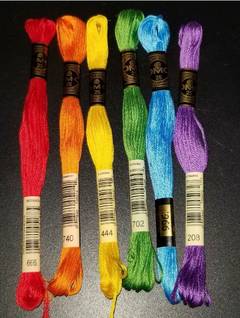
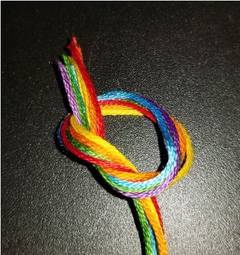
Candy Stripe
Start by cutting about 3 feet of each color: red, orange, yellow, green, blue, violet. Tie a knot at the end.
At this point, I sometimes include a safety pin in the knot to clip the bracelet to my clothing and keep it taut as I tie the knots. For this demo, I’ll be using a clipboard, which achieves the same goal.
If you’re adding a safety pin, do so now, and attach it to a pant leg to keep the bracelet in place and with you on the go. Alternative methods of securing the knot include the clipboard below or just taping the bracelet to your work surface. Spread out the colors, red to violet.
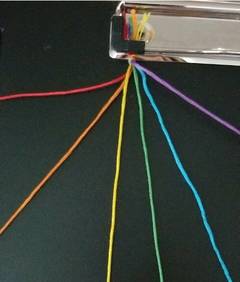
For the candy stripe, you’ll be using the same knot over and over again. It looks like this: arrange the two strings in the shape of a 4 by bringing the left string over the right and wrapping it underneath the right string (see figure below). Then repeat this same process again with those strings. This completes the “forward knot.” This knot swaps the position of the two colors so you can work a stripe across the whole bracelet. The entire bracelet will consist of forward knots with each color working your way from red to violet in succession.
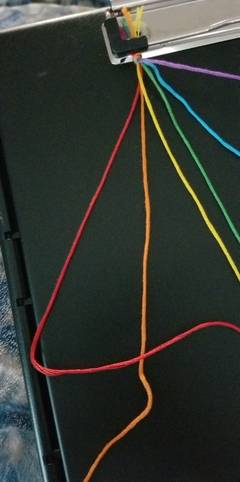
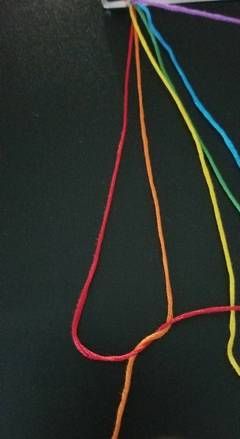
Forward knot: Take the red string, and tuck it under the orange string, then pull the knot tight, all the way to the top of the bracelet.
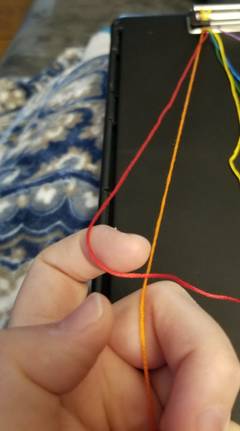
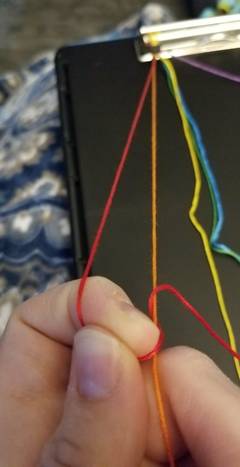
The knots may not look perfect on your first row. Don’t worry about it! Keep going one color at a time.
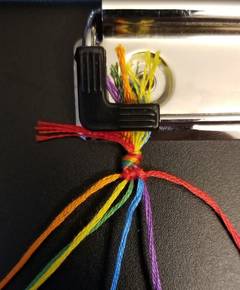
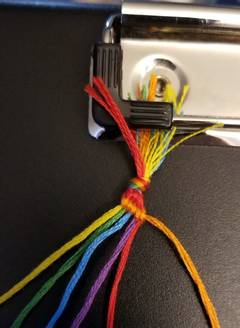
Once you get through the rainbow once, just keep repeating until the bracelet reaches your desired length!
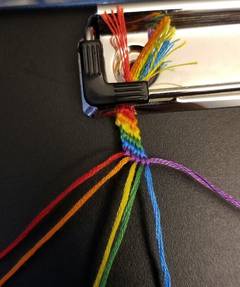
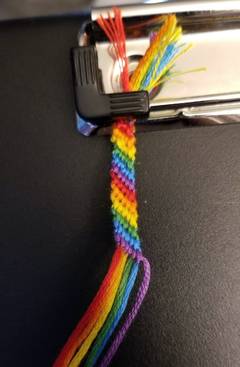
Rainbow Chevron
This will be largely the same as the candy stripe, but with a second knot variety and more strings to track. You’ll want to slightly more than double the length of string that was used for the first bracelet since they’ll be halved to make the pattern—approximately 7 feet should work. Again, you’ll want one of each color of the rainbow: red, orange, yellow, green, blue, violet. Tie a knot roughly the same as before, but leave a loop to help with tying the bracelet later.
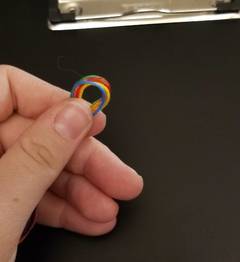
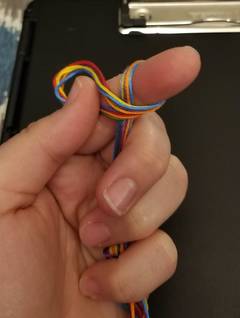

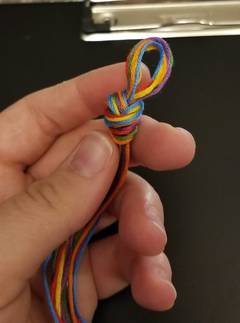
Fasten the bracelet:
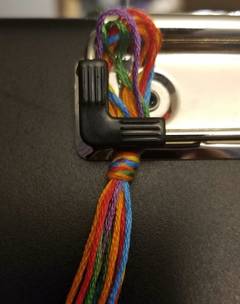
Arrange your strings in rainbow order starting from the middle. This will result in the red appearing to be the top once the chevron forms.
Start tying the forward knot across the strings from left to right. The first row of knots is the most important because it sets the order of the remaining strands. Start by tying violet over blue, then green, then yellow, then orange, then red.
Then tie a backward knot starting at the right-hand side and working your way through the same colors from right to left: blue, green, yellow, orange, red. If you need help visualizing the backward knot, I’ve included it below for the red string.
At this point, you’ll have your two violet strands in the middle. It doesn’t matter what knot you tie here since both strands are the same color. Continue the pattern with the remaining strings.
Forward knot:
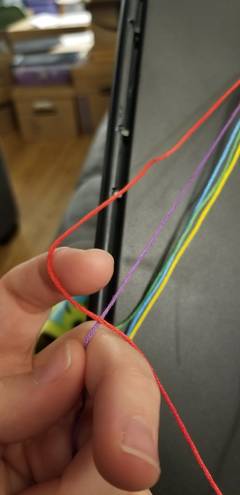
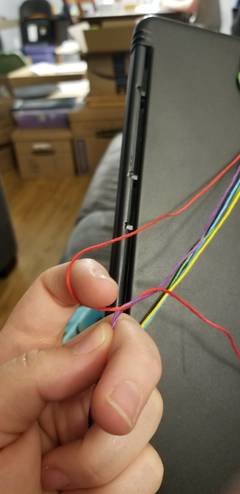


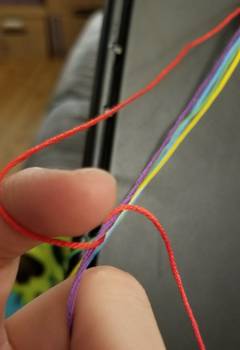


Backward knot:



LOVE–AHAVAH Alphabet Pattern
This last pattern is for an alphabet-style bracelet. Unlike the other patterns, this one consists of one very long string weaving back and forth across rows of background colors. Cut each color of the rainbow plus two black strands about 3 feet long. Measure about 9 feet of black string as the leading strand. Tie a knot at the top and fasten like the other examples. Arrange in rainbow order with one black strand on each far side and the long strand at the left.


Start with the leading (long black) string, tying forward knots across the rainbow strands left to right, slightly angling the knots to keep the line straight. Then tie backwards knots from right to left to establish the foreground color. The colored knots appear by tying a knot in the opposite direction to the leading strand. For example, for the L, start with a forward knot tied with the leading strand, then tie backward knots with each of the rainbow colors (red, then orange, then yellow, etc.) to get the vertical line of the L. Then tie a forward and a backward knot with the long background strand on the right black strand. Work your way back from right to left tying backward knots using the leading strand, tying a forward knot with the red to start the horizontal part of the L. Continue with this method to complete the entire words: LOVE–AHAVAH


Friendship bracelet pattern: I flipped the rainbow on my bracelet, but both orientations work great!

I went ahead and added a candy stripe at the end just for a fun flourish. Feel free to get creative with the pattern once you learn the basic knots!


Learn More about the Issues: What We’re Reading
06/10/2020 10:17:00 AM
| Author | |
| Date Added |

Social Action Committee members have been using their time at home to get caught up on reading. Here are reviews of three social justice titles.
One Person, No Vote: How Voter Suppression Is Destroying Our Democracy, by Carol Anderson
I was interested in reading this book after hearing a presentation by the author at the Book Festival here in Madison a year ago or so. By the chair of the Department of African American Studies at Emory University in Atlanta, Professor Anderson’s book is, in the words of one reviewer, “impeccably researched, deftly written and, sadly, prescient.” I would also add the word passionate. It’s a rare but incredibly effective combination to read a book that is both highly credible, due to its painstaking research, and fiery in its narrative. Gerrymandering, voter ID laws, closure of polling places, limiting early voting, and resisting vote-by-mail are just some of the tactics she chronicles in this deeply disturbing book. It’s a quick read, at only 160 pages (followed by more than 100 pages of notes).
As a lifelong Wisconsin resident, I have been horrified to see how much of our progressive tradition has been rolled back in the last 10 years or so, and the assault on the right to vote means Wisconsin joins the ranks of the other states Professor Anderson calls out in her book. In other words, if anyone thought that suppressing the vote of African Americans, Latinos, and other communities of color was only a southern-state thing, think again. Over and over this book made me drop my jaw, gasp, shake my head in disgust, and—most of all—propel me to action. I hope you’ll read it and join in the battle against these clearly racist efforts. No less than our democracy is at stake. —Betsy Abramson
The Death and Life of Aida Hernandez: A Border Story, by Aaron Bobrow-Strain
This book tells the story of a young, single, undocumented mother as she struggles to gain legal residency in the United States. It is a highly emotional and gripping story that allows us to go deeper into appreciating what it’s like to be an undocumented immigrant. The main character, Aida, is a complex person, and we grow to understand the choices she makes as we see the almost unimaginable trauma she goes through, both in her personal life and as a result of our cruel immigration policies. She perseveres in the face of all of this, wanting above all to give her young son a good life.
What made this book even more compelling for me is the weaving in of history, politics, and economics, which broadened my awareness of how our current immigration situation developed. Of note is the fact that this book is part of Dane Sanctuary Coalition’s “Big Read,” and the author is scheduled to speak in Madison on October 8. The Immigrant Rights Action Team facilitated a discussion of the book on May 26 with a possible additional one later in the summer if we get more interest. I highly recommend this book! —Lynn Silverman
Born a Crime, by Trevor Noah
Trevor Noah’s Born a Crimeis a hilariously funny, heartbreaking, and inspiring memoir about growing up in South Africa living under apartheid and its turbulent aftermath. Born in 1984 to a black Xhosa mother and a white Swiss father, Noah’s very existence was a crime under apartheid’s brutal laws. His narrative seamlessly interweaves comedy and tragedy as it takes us through his early family life, troubled school years, relationship with an abusive stepfather, and even a brief stint in jail before moving on to his remarkable later successes as a stand-up comedian and the astute social commentator who has hosted The Daily Showsince 2015.
The odds seemed stacked against Noah as they were and continue to be against the majority of South Africa’s black citizens, who are frequently trapped by the legacy of colonialism and apartheid and who continue to face poverty, oppression, violence, racism, and severely limited opportunities. Noah credits his success to his mother, who served as a powerful buffer against the brutality of the world they inhabited with her fiercely indomitable spirit and unconventional, uncompromising love. Born a Crimemakes for an extremely engaging, enjoyable, and fast-paced read. It not only provides an engrossing personal story of transcending trauma, but exposes the legacy of the damage inflicted by apartheid with excruciating honesty. If you listen to the audiobook, the author’s narration makes this remarkable story even more compelling. —Erica Serlin
Volunteer Opportunities and Partner Program Updates
06/10/2020 10:04:09 AM
| Author | |
| Date Added |

Last month we did a survey of our partner programs to see what they had done to adapt to rapidly changing conditions and what kind of support they needed. Here are updates on a few of these programs.
Catholic Multicultural Center

The Catholic Multicultural Center (CMC) meal program is currently a grab-and-go meal for guests to take with them from the CMC parking lot. Our volunteers are now cooking (in their homes) and dropping off meals every other Wednesday to meet the growing need. We cook meals for 80+ people by sharing recipes and dividing up the work. If you are interested in preparing food at home for delivery to CMC, please use the sign up genius link. Contact Sue Levy at 608-273-4527 if you have any questions.
Many thanks to the excellent Temple cooks who have already cooked at least 350 meals for appreciative Madisonians at Catholic Multicultural Center who needed a helping hand.
Porchlight
Porchlight has opened two new shelters to provide more housing and to separate men who are sick from those who are healthy. The Food Fight restaurant group provides catered meals for both shelters, so no meals are currently needed from volunteers. The Warner Park shelter is working well while serving anywhere from 65 to 95 men per night. They are in need of volunteers to do the nightly health assessments at the Warner Park Men’s shelter, from 5:00 pm to 8:00 pm at 1625 Northport Drive. Volunteers will be given gloves and N95 masks and training. If interested, please email Kim Sutter.
Porchlight has been in the news lately:
You can read about their innovative COVID-19 screening process in this article from U.S. News and World Report.
The Wisconsin State Journal offers an in-depth look at the city’s exploration of alternatives to the prior program providing shelter in church basements.
And this PBS article talks about the impact of COVID-19 on people experiencing homelessness in Wisconsin.
Healing House
Healing House is operating and has implemented safety protocols. They are working closely with city and county staff and other homeless service providers to keep residents safe. So far the congregational meal program is continuing in modified form as volunteers drop off uncooked meals to be cooked by staff. TBE will be cooking meals next during the week of August 9 to August 15. You can sign up to volunteer here.
Thoreau and Emerson Elementary Schools
The Madison Metropolitan School District (MMSD) is asking people to support MMSD families by volunteering with their partner agency, Second Harvest Foodbank of Southern Wisconsin. In order to meet the food needs of vulnerable families while protecting the health and safety of volunteers, Second Harvest has moved to the distribution of pre-boxed groceries, calling it their “Care Box Campaign.” You can support this campaign by donating or volunteering your time. Sign up here to volunteer and here to donate.
United Way Volunteer Opportunities
United Way of Dane County has compiled a list of volunteer opportunities specifically needed during the pandemic. United Way also offers a guide to safe practices for volunteering your time and donating material goods. They are currently looking for hospice visitors, food bank warehouse workers, virtual home check-ins for seniors, meals on wheels delivery, virtual ESL and literacy tutoring, food pantry gardeners, and many other positions.
Solidarity with the African American Community after the Death of George Floyd
06/10/2020 09:52:42 AM
| Author | |
| Date Added |

On May 29, Rabbi Jonathan Biatch and Rabbi Bonnie Margulis sent this letter to leaders in the African American community of Madison in the wake of the murder of George Floyd in Minneapolis:
Dearest friends and colleagues,
Our words fail us, but our outrage and horror haunt us again when, at this terrible time, yet another African American has been killed at the hands of the police. We cannot imagine the pain and anger, frustration and outrage you must be feeling. The murder of George Floyd is abhorrent, as is the lack of accountability on the part of the police department and the city government. There is no adequate consolation that we can offer for the violence, the death, the manifestation of systemic racism blatantly at work here. Yet, we stand with you and pledge to act with you in protesting these outrageous acts of inhumanity. We are taught to love our fellow as we love ourselves, and we are completely distraught that many Americans have failed to learn this lesson.
Please know that we in the Jewish community and in Wisconsin Faith Voices for Justice are prepared to stand with you in whatever way you feel would be the most helpful. We sincerely thank you for your leadership in the Madison community.
We know there is more we can do, and we stand by with our love, our energy, and our substance to be of assistance. The Social Action Committee met on Thursday, June 4, to explore ways that we can support the African American community in the struggle for justice.
As our Racial Justice Action Team continues its advocacy work, we hope you will join us in moving the country to becoming a place of peace and wholeness for all. Please contact Betsy Abramson.
Controversy Continues over Pandemic Restrictions
06/10/2020 09:45:42 AM
| Author | |
| Date Added |

As COVID-19 precautions move into a new phase, Temple Beth El has created a task force toestablish safe practices as we prepare for a gradual return to communal life. On the national level, controversy has grown over whether houses of worship should be allowed to reopen for large gatherings. Rabbi Rick Jacobs, president of the Union for Reform Judaism, issued the following statement on May 22 on behalf of the Reform Jewish Movement:
“We have known for millennia that houses of worship are essential institutions. While we long to gather in person, we believe that there is no higher value than pikuach nefesh, saving a life. We are entrusted with the holy responsibility of being God’s partners in that work. The Reform Jewish Movement will continue to look to the wisdom of medical professionals to guide us on when reopening our synagogues can be done safely in keeping with our values.”
Rabbi Jacobs’s view is shared by many faith leaders in Wisconsin. These leaders spoke out in April by signing an amicus brief to the Wisconsin Supreme Court in favor of maintaining the Safer at Home order. The brief was supported by 131clergy and faith leaders—Protestants, Catholics, Quakers, Jews, and Buddhists—refuting the lawsuit’s contention that the order led to “decreased access to community and religious support.” The brief included 29 letters describing the strength, resiliency, and creativity of faith communities in moving their worship, pastoral care, religious instruction, and programming online. The statements highlighted how moving online made worship and other activities more rather than less accessible to those who would otherwise have been unable to participate due to age, disability, or geographic distance. Despite the disadvantages of not gathering in person, these religious leaders share a commitment to avoid putting members or anyone else at physical risk.The amicus brief was filed by Wisconsin Faith Voices for Justice, of which the TBE Social Action Committee is a supporting member.
Good News from Jewish Social Services: The Welcoming Tradition Continues
06/10/2020 09:34:11 AM
by Rabbi Renee Bauer, JSS Community Chaplain
| Author | |
| Date Added |

In a time when challenging news and disappointments permeate the airwaves and immigration to the United States has essentially been halted, we are delighted to be helping newcomers become lawful permanent residents of the United States. Since the Safer at Home order went into effect in mid-March, five JSS clients have received their green cards, and Carrie Fox-Kline, director of immigration legal services at JSS, has submitted nine more applications.
Most of these green cards are for refugees we have resettled. Refugees can apply for a green card a year after arriving in the United States. In my experience with our refugee clients, many of them are focused on the goal of becoming citizens and anxiously await becoming lawful permanent residents. This status is the first step toward citizenship and creates a deepening sense of being settled and safe in their new country. Carrie shared with me the joyous reactions of her clients who just received their green cards.
But it is not only refugees that JSS helps to obtain green cards. Maya Garbuz, case manager, also sees clients who need immigration legal assistance. A few months ago, a young man lost his green card, and without it, he could not find any employer willing to hire him. Maya supported this young man in his applying for a replacement card on his own. He recently received it and is already interviewing for jobs.
Another young man who came to JSS as a social services client just received his social security card. He came to the United States as a child with his mother, who married an American citizen. The man was very abusive, and the woman and her son had to leave. They had no status, as the husband/stepfather never applied for social security or a green card. The son came to see Maya, who provided social services and support while he obtained legal help to apply for legal status through the Violence Against Women Act (VAWA). His VAWA petition was approved. He can now get a job, which he could not do without legal status.
These stories shine a bright light during a dark time for immigration in our country. Since late March, refugee resettlement, naturalization ceremonies (to complete the process of becoming a citizen), and issuance of green cards to those outside the United States (with some exceptions) have been halted. The United States has closed the southern and northern borders to nonessential travel, and more than 20,000 migrants have been immediately sent back to Mexico or their home countries. Only two migrants have been allowed to remain in the United States to pursue asylum, and the administration is moving to extend its coronavirus border restrictions indefinitely despite the push to reopen business inside the country.
The Jewish story is one of immigration, and protecting the vulnerable is at the heart of our tradition. JSS, which has a long history of serving and advocating for immigrants, will continue to do so, and we invite you to join us in this commitment.
It’s Not Too Soon to Request an Absentee Ballot for the Fall Elections
06/10/2020 09:27:21 AM
| Author | |
| Date Added |

It’s fair to say that the April election did not go as smoothly as the people of Wisconsin might have hoped. Last-minute court challenges led to confusion, voters in some locations stood in line for hours, and social distancing was often difficult. Municipal clerks were hard-hit by a flood of last-minute absentee ballot requests, and voters who didn’t get their ballots on time either went to the polls despite the Safer at Home order or gave up their right to vote.
If you would like to vote by mail in the fall elections, now is the time to request your absentee ballot. All Wisconsin voters are able to request an absentee ballot without providing a reason—you don’t actually have to be absent. While the Wisconsin Elections Commission decided on May 27 to mail absentee ballots to all registered voters, the April experience suggests that more challenges may lie ahead.
If you are already registered to vote, the easiest way to request a ballot is online at MyVote.wi.gov. You will be required to upload a copy of your voter photo ID if one is not already on file with your municipal clerk. You can also request an absentee ballot by contacting your municipal clerk by mail or email. City of Madison residents may request an absentee ballot form; any other municipality should use this form.
Social Action Shabbat Will Focus on Voting Rights
06/10/2020 09:24:07 AM
| Author | |
| Date Added |

On August 28, the Social Action Committee will welcome Ryeshia Farmer, coordinator of the “Rights for All” campaign of the ACLU of Wisconsin. Ms. Farmer will talk about the multitude of issues swirling around voting rights, including mail-in ballots, keeping polling places open, voter ID, felon disenfranchisement, disability access, voter roll purges, and more. The TBE Civic Engagement Action Team will offer concrete actions we can take to protect and expand the right to vote for every American.
Through our focus on voting rights, we are participating in a national campaign with synagogues across the country. “Every Voice, Every Vote” is the Reform Jewish movement’s 2020 civic engagement campaign, a nonpartisan effort to strengthen our democracy by encouraging everyone to participate in the U.S. election and ensuring that Reform Jewish values are represented in the public square. You can read more about it here.
Throughout the summer and fall, the TBE Civic Engagement Action Team will be working on these issues. Join us on August 28 as we learn what we can do to make voting available for all citizens.
“My Faith, My Vote, My Story”: Leaders Speak Out on Why Voting Matters
06/10/2020 09:17:07 AM
| Author | |
| Date Added |

The Wisconsin Interfaith Voter Engagement Campaign has launched a new series of short videos called “My Faith, My Vote, My Story” as a way to promote civic engagement while social distancing. In these videos, community leaders talk about times when they encountered barriers to registering or voting, how their faith tradition inspired them to vote, or why their faith tradition leads them to work so that everyone has the right to vote and have a voice. You can find the first round of videos on the InterfaithVoteWI website. If you have a story to share, you'll find instructions for how to do that here.
The campaign also recently hosted a webinar called “Forward in Faith and Power: Why Your Vote Matters,” featuring office holders and faith leaders talking about the importance of voting, particularly in local elections. Many eligible voters are apathetic and hopeless, feeling that their votes don’t count. Others may vote in presidential elections but don’t think that local elections are important. In the webinar, people talk about faith as an inspiration for taking voting seriously and the impact of voting on day-to-day life. You can watch this webinar online or share it with someone you know who isn’t sure why they should bother to vote.
If you’d like to get involved in nonpartisan voter outreach, you can sign up for the TBE Civic Engagement Action Team (contact Marcia Vandercook)and/or the Wisconsin Interfaith Civic Engagement Project (contact Rabbi Bonnie Margulis).
Presentation to Highlight the Impact of COVID-19 on Immigrants Held in Detention
06/10/2020 09:12:56 AM
| Author | |
| Date Added |

On Monday, June 22, 7:00–8:30 pm, the Immigrant Rights Action Team is hosting a Zoom presentation by Aissa Olivarez, the managing attorney at the Community Immigration Law Center (CILC). She will talk about the impact of COVID-19 on undocumented immigrants in detention and the need to release these detainees for health reasons. Conditions in the detention centers have become even more dire with the spread of COVID-19, since the centers have no capacity for social distancing or adequate protection and medical care.
Ms. Olivarez will also summarize virtual trainings recently attended by CILC's attorneys to enhance legal representation of immigrants facing deportation using funds obtained by the TBE Immigrant Rights Action Team. These funds were provided by the Gilbert and Eleanor Kraus Initiative for Immigrant and Refugee Justice at the URJ Religious Action Center in the form of a $1,500 grant.
At the end of the program, listeners will be asked to send a letter urging our legislators to press for the release of immigrant detainees, consistent with the RAC's current advocacy priorities. This program is open to all interested TBE congregants and to other Dane Sanctuary Coalition member congregations.
Sign up for this program here.
LGBTQ Pride Resources
06/10/2020 08:29:04 AM
| Author | |
| Date Added |

Books
Queer Jewish Narratives (LGBTQIA+ Reads)
A comprehensive list of over 50 fiction and non-fiction books for adults, young adults and children. Includes extensive descriptions.
Confronting History: A Memoir
George L. Mosse, University of Wisconsin Press, 2000
Recommended by Paul Grossberg
George Mosse was the John C. Bascom Professor of European History and the Weinstein-Bascom Professor of Jewish Studies at the University of Wisconsin-Madison. He was also the Koebner Professor of History at the Hebrew University in Jerusalem and was selected to be the first scholar-in-residence at the Holocaust Museum in Washington, D.C.
George Mosse finished writing his memoir just two weeks before he died in January 1999. Confronting History describes Mosse’s opulent childhood in Weimar, Berlin as the son of a prominent newspaper publisher, his exile in Paris and England, his second exile in the Unites States at Haverford, Harvard, Iowa, and Wisconsin, and extended stays in London and Jerusalem. Mosse also discusses being a Jew and his attachment to Israel and Zionism, his gayness, his coming out, and his growing scholarly interest in issues of sexuality.
We’ve Been Here All Along: Wisconsin’s Early Gay History (2019)
R. Richard Wagner, Wisconsin Historical Society Press
Comments from Paul Grossberg:
"This outstanding book, We’ve Been Here All Along: Wisconsin’s Early Gay History, takes readers on a fascinating journey through decades of engaging stories, societal and political insight, and carefully referenced details. My husband and I have known Dick Wagner for about 40 years. He is a friend, a clear-thinking community leader, a soft-spoken and brilliant historian, and a mensch. Our entire community has been given a meaningful gift with these unearthed stories and threads of progress woven together in such a beautiful way. We can’t wait for the next volume."
If any Temple Beth El members would like a personally autographed copy please email Paul Grossberg who will help arrange that.
We’ve Been Here All Along: Wisconsin’s Early Gay History received a Gold Book Award in the national 2020 Independent Publishers Book Awards contest and received a Book Award of Merit from the Board of Curators of the Wisconsin State Historical Society. Wisconsin Public Television will be re-broadcasting Dick Wagner’s UW Sociology Department lecture about Wisconsin’s Early Gay History at noon Wednesdays during Pride Month, June 2020.
Coming Out, Moving Forward (Available September 2020)
R. Richard Wagner, Wisconsin Historical Society Press
Forewords by Tammy Baldwin and Steve Gunderson
Here’s what Tony Earl (Wisconsin Governor from 1983-1987) said about Coming Out, Moving Forward: “Thank goodness for R. Richard Wagner’s careful documentation and historic recounting of the push for LGBT rights in Wisconsin. Otherwise, it would be difficult to comprehend, by today’s standards, the depth and breadth of the prejudice. Wisconsin was on the forefront, albeit with fits and starts, of the fight for equal rights, thanks to the tenacity and hard work of people like Wagner. I am proud to have been a chapter in this movement.”
If any Temple Beth El members would like a personally autographed copy please email Paul Grossberg who will help arrange that.
Torah Queeries: Weekly Commentaries on the Hebrew Bible, edited by Gregg Drinkwater, Joshua Lesser, and David Shneer
edited by Gregg Drinkwater, Joshua Lesser, and David Shneer
Recommended by Cantor Jacob Niemi (in the TBE library)
This is an incredibly important contribution to the canon of queer Jewish theology and textual interpretation, in some ways the first book of its kind. Building upon the great strides made by Jewish feminist thinkers, LGBTQ Jews have taken up the mantle of reading themselves and their experiences back into texts that have historically excluded their voices. Just as feminist Jewish theology has provided new and deeply meaningful ways for Jews of every gender to read sacred text, so too does the lens of queer theory and theology provide a wellspring of insight that can benefit people of all sexual orientations and gender identities.
A Rainbow Thread: An Anthology of Queer Jewish Texts from the First Century to 1969, edited by Noam Sienna
edited by Noam Sienna
Recommended by Cantor Jacob Niemi (in the TBE library)
Much in the same way that Torah Queeriesis a momentous book in its elevation of contemporary queer Jewish readers of sacred text, A Rainbow Thread is equally significant in its collection of voices from and about queer Jewish experiences of the past. While labels may change to suit the needs of a generation, Noam Sienna’s book teaches us (among many other things) that much of the human experience has remained the same. We have all wrestled with identity, searched for meaning, and sought ways to celebrate our full, authentic selves.
Wrestling with Gods and Men: Homosexuality in Jewish Tradition, by Rabbi Steven Greenberg
by Rabbi Steven Greenberg,University of Wisconsin Press, 2004
Recommended by Cantor Jacob Niemi (in the TBE library)
Written by the first Orthodox rabbi to come out as gay, and then maintain his identity as an orthodox rabbi, Steven Greenberg’s landmark book delves into topics that have tortured gay, lesbian, bisexual, and queer people of faith for generations. Specifically, Rabbi Greenberg explores the biblical prohibitions against certain sexual acts that have been used to marginalize and persecute LGBTQ people. Using his Orthodox perspective, he proposes a halakhic framework by with LGBTQ Jews can be fully accepted within even the most religiously strict of communities. His work has opened the door to a new way of thinking for a generation of queer Jews who refuse to separate their faith their acceptance of their sexual orientation and/or gender identity.
Other books on Cantor Niemi’s Jewish LGBTQ+ reading short list
History and Memoirs
- Balancing on the Mechitza: Transgender in the Jewish Community, edited by Noach Dzmura (in the TBE library)
- Changing Lives, Making History: Congregation Beit Simchat Torah, The First 40 Years, by Rabbi Ayelet Cohen
Miscellaneous Non-Fiction
- Adrienne Rich’s Poetry and Prose, by Adrienne Rich
- Nice Jewish Girls: A Lesbian Anthology, edited by Evelyn Torton Beck
Reference
- Mishkan Ga’avah: Where Pride Dwells: A Celebration of LGBTQ Jewish Life and Ritual, edited by Rabbi Denise L. Eger. In honor of Pride month, CCAR Press is offering 20% off Mishkan Ga'avah: Where Pride Dwells a collection of LGBTQ prayers, poems, liturgy, and rituals with discount code PRIDE20 at checkout through June 15, 2020.
- Queering the Text: Biblical, Medieval, and Modern Jewish Stories, by Andrew Ramer
Theology
- The Soul of the Stranger: Reading God and Torah from a Transgender Perspective, by Joy Ladin
- God vs. Gay: The Religious Case for Equality, by Jay Michaelson
- Textual Activism, by Rabbi Mike Moskowitz
- Listening for the Oboe, by Rabbi Sharon Kleinbaum
Children’s
- The Purim Superhero, by Elisabeth Kushner, illustrated by Mike Byrne (in the TBE library)
- Pride: The Story of Harvey Milk and the Rainbow Flag, by Rob Sanders, illustrated by Steven Salerno
Young Adult
- Magical Princess Harriet, by Rabbi Leiah Lin Moser (in the TBE library)
Events
Outreach Magic Festival Madison
Transgender and Non-Binary Jews Are Here: A National Convening
Cantor Niemi: "In the spring of 2019, Keshet and Congregation Beit Simchat Torah hosted the first ever convening of transgender and nonbinary Jews. Hundreds of trans and nonbinary Jews from all across America converged upon New York for a weekend of learning, networking, resource sharing, and community building. I was only able to witness a few pieces of this unprecedented event (as they opened worship to the host-congregation), and I was profoundly moved and inspired by the power of this awakened collective. Only time will tell the magnitude of what these newly forged connections may provide to the Jewish world. (Side note: It was through this convening that I was exposed to the work of Abby Stein, Rabbi Leiah Lin Moser, and Rabbah Rona Matlow, among others)"
For Allies
Seven Jewish Values for Inclusive Community
How traditional Jewish values serve as guidelines for creating an inclusive community
Supporting Your LGBTQ Child
Learn how to show true love and support for the LGBTQ young person in your life
What’s in a Pronoun?: Resources and Activities on Third-Person, Gender- Neutral Pronouns
A guide to pronouns and gender-neutral pronouns, with an emphasis on addressing questions about using “they” as a singular pronoun.
Historically LGBTQ Synagogues
Congregation Beit Simchat Torah in New York City
Beth Chayim Chadashim in Los Angeles
From Cantor Niemi: "While all of these historically LGBTQ synagogues now welcome straight and cisgender members, the role that they have played and continue to play for LGBTQ Jews searching for meaning and community cannot be emphasized enough. During my cantorial studies, I personally found this to be the case, as I explored the synthesis of my own queer and Jewish identities, and how that synthesis could inform my sacred work. In particular, I found the opportunity to engage with an inter-generational queer Jewish community to be profoundly meaningful, as I gained access to shared history to which I had never been exposed."
Jewish Ritual
Queer/Chosen Family Blessing for the Children
Judaism has a beautiful tradition of blessing the children on Friday night before making kiddush. The traditional blessing is gendered with a version for daughters and one for sons, as they are blessed to be like the matriarchs or Ephraim and Manasseh. But not all families fit this model; not all children fit the gender binary, and not all families consist of parents and children.
TransTorah
From Cantor Niemi: "While the website design might seem a little outdated, TransTorah is a vital and currently irreplaceable resource for those who which to learn more about ritual and theology developed by and for transgender Jews. From sermons and essays to prayers for transitioning and chest-binding, and even some medieval poetry, this website is an invaluable resource for transgender Jews and their allies. In addition to the amazing ritual innovation, I found it profoundly meaningful to read sermons, essays, and poetry by the first generation of openly transgender rabbis."
Queer Nigun Project
From Cantor Niemi:“Only in New York…” Well, it’s true that sometimes you need a critical mass of Jews in a confined geographical area for this kind of innovation. In any case, the beautifully simple power of this gathering (now virtual) is hard to overstate. It is a group of LGBTQ Jews in New York (mostly Brooklyn) who gather and sing nigunim (wordless melodies)…and that’s it (though I guess they sometimes bring snacks). The healing and resilience and meaning that this space provides for LGBTQ Jews, many of whom have been estranged from religiously orthodox and/or politically conservative families and communities, is remarkably powerful. I was fortunate to go to a few of their gatherings (and even host once) before I left New York, and I still draw upon their treasure trove of online recordings whenever I am seeking a new nigun."
A group of queer Jews, based primarily in Brooklyn, that gathers on a regular basis to simply sing nigunim together. It’s run by the daughter of a chabadnik, a young woman who learned a trove of nigunim from her father. Participants are encouraged to share nigunim they know, and some sessions have even led to the sharing and composition of new nigunim. The gatherings initially provided a space for many queer Jews who had felt estranged from their Judaism or their Jewish community, particularly those who came from an Orthodox background, but they quickly expanded and became part of the rapidly growing, inter/trans-denominational, LGBTQ-affirming, Jewish scene in Brooklyn (and, to a certain degree, Washington Heights).
Non-Binary Hebrew Project
From Cantor Niemi: "Quite apart from the meaningful resource this has become for non-binary Jews and Hebrew speakers, the Hebrew grammar enthusiast in me is remarkably impressed and fascinated by the comprehensive approach of this project. Anyone who studies Hebrew knows that it is one of THE most gendered languages, where even 2ndperson pronouns and present tense verbs must be gender-specific. To my knowledge, this is the first attempt to take a wholistic and systematic approach to creating a gender-neutral option in Hebrew. While it has its flaws, it also has incredible potential, and it is already inspiring many non-binary Jews (including some future clergy, one of whom I am fortunate to call a friend)."
Queer Midrashim by Rabbah Rona Matlow
Ritualwell
A TON of resources for ritual (mostly not LGBTQ-specific, but they have a respectable quantity that is). Here's a guide for their LGBTQ-specific resources that was published in 2013.
LGBTQ History
How the Nazi Regimes Pink Triangle was Repurposed for LGBT Pride
Contains LGBTQ history in Europe before and during the war and why the pink triangle has been adopted as a positive symbol.
Looking at the Gay Rights Movement Through Art
Fabulous! Provides history of pride flag. Shows art of several artists' with descriptions.
Wisconsin LGBT History Project
Chronicling the history of the LGBTQ community in Milwaukee and Wisconsin.
LGBTQ People and Identities
6 Influential Jews Who Show their LGBT Pride
One paragraph about each person and links for more information on each one.
Dag Gadol
A blog/website by the Rabbi Leiah Lin Moser (who happens to be trans, a very cool human being, and one of the authors on my book list – Cantor Niemi). The website contains many of her drashot and essays, as well as ways to purchase her books.
Honoring LGBT Jewish Holocaust Survivors
A list of blog biographies and additional resources on 11 inspirational LGBTQ Jewish Holocaust survivors compiled by the New York Public Library
How I Learned to Love my Big Gay Jewish Hair –“ the way I wear my hair is layered with cultural meaning and intention”
A short film about how one person presents both his Jewish and gay identities through his hair and struggles with these identities. Here’s an interview with the star and producer of the film a while after it was made.
I Am Always All Parts of My Identity—and I Hope You Are, Too BY EVERLYN A. HUNTER
Jewish Pioneers in LGBT Rights, LGBT Achievements in Judaism and Others
A compilation of achievements, brief biographies and additional resources of amazing accomplishments
Keshet’s “Joy and Resilience” series
Cantor Niemi: "An innovation in response to the Covid-19 pandemic, Keshet’s online video series invites LGBTQ Jewish leaders to engage in interview in which they discuss sustains them when facing adversity and crisis. Quoting the host/interviewer, Dubbs Weinblatt, 'As LGBTQ Jewish people, oftentimes, we need to create our own ways of persevering through tough moments. Surviving and thriving in this world has pushed our own store of unique wisdom about resilience, joy, and community.' In listening to these interviews, I was moved not only by how the perspectives shared might resonate with LGBTQ Jews, but also by the powerful messages that these leaders have to share with the Jewish community at large."
Michael W. Twitty
A proud black, Jewish and gay man who fuses his identities together in his own special unique blend of kosher soul, culinary influencer, historian, Judaic studies teacher and so much more.
Resources from Abby Stein
Cantor Niemi: "A former ultra-orthodox rabbi who came out as trans, left the Orthodox world, and found her way back to Jewish community. I was fortunate to hear her speak at a number of events, including Trans Jews Are Here: A National Convening that took place a little over a year ago. Her personal story is powerful, and her knowledge of text is impressively broad and deep. In addition to her blog and her Sefaria source sheets, both of which are great resources, she also has a new book that came out last November, in which she tells the story of her journey thus far."
Yitz Jordan (Y-Love)
Hip-hop artist, educator and activist who is Jewish, Black and Gay
Organizations
GSAFE
Increases the capacity of LGBTQ+ students, educators, and families to create schools in Wisconsin where all youth thrive.
HUC-JIR’s Institute for Judaism and Sexual Orientation
The Institute for Judaism, Sexual Orientation & Gender Identity at Hebrew Union College-Jewish Institute of Religion (HUC-JIR) is the first and only institute of its kind in the Jewish world. The Institute was founded in 2000 to educate HUC-JIR students on lesbian, gay, bisexual and transgender issues to help them challenge and eliminate homophobia and heterosexism; and to learn tools to be able to transform the communities they encounter into ones that are inclusive and welcoming of LGBT Jews.
Over time, this mission of education and the creation of welcoming spaces has expanded to the larger community outside the walls of our four campuses in Los Angeles, Cincinnati, New York and Jerusalem. The Institute offers consultation to individual professionals, synagogues and organizations as well as seminars and workshops at HUC-JIR and at local, national and international conferences.
Keshet
Keshet works for the full equality of all LGBTQ Jews and our families in Jewish life.
OutReach LGBT Community Center
Mission is a commitment to equity and quality of life for all LGBTQ+ people through community building, health and human services, and economic, social, and racial justice advocacy. Coordinators of the Madison Pride MAGIC Festival
PFLAG: Parents, Families and Friends of Lesbians and Gays
National & Local chapter
PFLAG promotes the health and well being of gay, lesbian, bisexual, transgender and questioning persons, their families and friends through:
- Support, to cope with an adverse society
- Education, to enlighten an ill-informed public
- Advocacy, to end discrimination and to secure equal civil rights
Reform Movement and the Religious Action Center
Since 1965 the Reform Movement has been an advocate of the LGBTQ community and continues their advocacy and celebrating successes today. Visit their website for how you can get involved in advocacy as well as other inclusive resources. They also have a history of the intersection of the Reform Movement and the LGBTQ Movement.
Svara: A Traditionally Radical Yeshiva
A queer yeshiva dedicated to the serious study of Talmud through the lens of queer experiences. Check out videos and other resources for learning and more on their website. They also host a Queer Talmud Camp that’s on Cantor Niemi’s bucket list.
Youth
Best Colleges for LGBTQ Students
Best colleges for LGBTQ students and other resources for the college search and campus life. (uses information from Campus Pride)
Campus Pride
Building future leaders and safer, more LGBTQ-friendly colleges and universities.
Jewish Queer Youth
Jewish Queer Youth (JQY) is a nonprofit organization supporting and empowering LGBTQ youth in the Jewish community. JQY fights to ensure the emotional and physical health and safety of these individuals, with a special focus on teens and young adults from Orthodox, Chasidic, and Sephardic communities. They have resources for parents as well as youth and so much more.
LGBTQIA + Resources for Children: A Bibliography
A far-reaching list of fiction, nonfiction, magazines, reference books, videos and websites. Compiled by the San Francisco Public Library and the Philadelphia Free Library
On the Killing of George Floyd
05/31/2020 03:57:29 PM
Rabbi Jonathan Biatch
| Author | |
| Date Added |
(NOTE: Since I wrote this post, some readers have inferred that a reference below blamed those protesting in memory of George Floyd and in favor of Black Lives Matter for the property damage and looting that stemmed from the demonstrations here, and possibly be extension around the nation. I do not believe this; this is not the case, and I regret that I was not more precise. I have, therefore, edited my original posting – written one day after the Madison demonstrations – to bring clarity to my words. I apologize for causing readers to misinterpret my intention.)
Judaism and Jewish textual tradition assert that all people on earth are equal, irrespective of any apparent or inherent differences. The Midrash explains that common descent from Adam and Eve means that no one’s ancestors are greater than any other: each person is precious in the eyes of God, and each person deserves the same dignity as anyone.
This is why the systemic racism in our nation is so disturbing. For yet again, our nation is reeling from the aftereffects of another death of a young African American at the hands of police. The deeply troubling, almost nine-minute recording depicting the killing of George Floyd should move each of us to reach out to our neighbors, friends, and relatives, and implore them to struggle against the systemic racism of our society.
As the mayor (Jewish, by the way) of Minneapolis said, “What we've seen over the last two days ... is the result of so much built-up anger and sadness, anger and sadness that has been ingrained in our black community, not just because of five minutes of horror, but 400 years [of systemic racism] … If you’re feeling that sadness and that anger, it’s not only understandable, it’s right.”
This past Friday morning, my wife Rabbi Bonnie Margulis and I sent this letter to the leaders of the Madison African American community. We have shared many moments of brotherhood in the last few years:
“Our words fail us, but our outrage and horror haunt us again when, at this terrible time, yet another African American has been killed at the hands of the police. We cannot imagine the pain and anger, frustration and outrage you must be feeling. The murder of George Floyd is abhorrent, as is the lack of accountability on the part of the police department and the city government. There is no adequate consolation that we can offer for the violence, the death, the manifestation of systemic racism blatantly at work here. Yet, we stand with you and pledge to act with you in protesting these outrageous acts of inhumanity. We are taught to love our fellow as we love ourselves, and we are completely distraught that many Americans have failed to learn this lesson…”
And like many cities in our nation, rioting has broken out in our downtown/State Street area, including property damage, looting, graffiti painting, and attacks against Madison’s Police Department and other law enforcement officers.
It has become evident that those who instigated this violence were not the peaceful protestors of Saturday afternoon. The identity of these perpetrators is not clear, but I suspect they were agitators from the extremes sides of the political spectrum: from the right, white supremacists who want to attach the stain of violence to the legitimate protestors, thereby hurting their justifiable protests; and from the left, anarchists and antifascists who feel that disruption of the social order is an effective and acceptable method of changing society.
Whoever they were, none of them seemed to have any connection to those calling for changes in the policing system and justice for all those young African Americans who have needlessly suffered or who have been killed at the hands of police.
As our mayor and other city officials said this past Saturday evening, the property damage and senseless rioting does nothing to help the cause of social justice or criminal justice reform. There is no reason to hurt others physically or psychologically because of our anger to the social issues that plague us.
We can’t predict the end result of the current wave of violent confrontations, but please remain current in knowing what’s going on, protect your friends and family, act sensibly, and continue to think of constructive ways to end the systemic racism that plagues our society.
Quarantine Kitchen - Smoked Salmon
05/26/2020 12:17:45 PM
Herb Jahr
| Author | |
| Date Added |
How to video: https://youtu.be/fCFv6M-HQAI
Ingredients:
- Sugar
- Salt
- White Wine
- 2 lbs salmon filets
- Worcestershire sauce
- Soy sauce
- Franks hot sauce or tabasco sauce
- Onion powder
- Garlic powder
- Wood chips
- Smoker
Instructions:
Take the salmon and rinse it off under water. It is best to have salmon with skin on it, but is not necessary.
Mix equal parts of sugar and salt with 2 cups of warm water and 2 cups of white wine – 4 cups of liquid total is necessary. Mix little bit of Worcestershire sauce, soy sauce, Franks Hot Sauce or Tabasco sauce. Approximately ¼ of a cup of this liquid is enough. Add onion and garlic powders to taste.
In a 13 by 9 inch pan, pour a little of the brine in the bottom of the pan. Next place the salmon to be smoked in the pan and pour the balance of the brine over the salmon. Add enough liquid until the fish begins to float, adding water if necessary. Brine the salmon for 6 hours overnight, in the refrigerator, covered.
After it’s brined for 6-8 hours, place the salmon on a rack to drain. Cut the salmon for easier handling. Place salmon directly on a rack sprayed with non-stick oil. Cut the salmon into large pieces that are easier to handle than the whole fish. Place the racks with the pieces of salmon in front of a fan to dry. The goal is to develop a shiny, dry skin.This is called a pellicle. The pellicle seals and creates a sticky surface on the fish for the smoke to adhere to, this should take about 4 hours. Drying the fish is vital.
Time to smoke the fish. Follow your smoker instructions, add water to the water trey, and using wood chips, smoke the salmon for 6 hours. Start at 100 degrees for 2 hours, then 145 degrees for 2 hours and finally 175 degrees for the final 2 hours. You may opt to add more wood chips before the last 2 hours.
November 3, 2025
12 Cheshvan 5786
Worship Schedule
-
Friday ,
NovNovember 7 , 2025Swarsensky Memorial Weekend Shabbat Worship: Can the Interfaith Endeavor Survive Today’s Schisms?
Friday, Nov 7th 6:00 pm to 7:15 pm
Swarsensky Memorial Weekend Shabbat Worship including Rabbi Dena Feingold speaking on "Can the Interfaith Endeavor Survive Today’s Schisms?" -
Saturday ,
NovNovember 8 , 2025Torah Study
Saturday, Nov 8th 9:00 am to 10:00 am
-
Friday ,
NovNovember 14 , 2025Likrat Shabbat (Welcoming Shabbat)
Friday, Nov 14th 6:00 pm to 7:00 pm
The first Friday of each month is an all-ages Shabbat service with participation by Religious School students. Join us in welcoming Shabbat as students from each grade participate by leading a portion of the worship. -
Saturday ,
NovNovember 15 , 2025Torah Study
Saturday, Nov 15th 9:00 am to 10:00 am
-
Friday ,
NovNovember 21 , 2025Shabbat Midor Lador
Friday, Nov 21st 6:00 pm to 7:15 pm
A musical service for the whole Temple family, with Les Goldsmith and the Promised Band. -
Saturday ,
NovNovember 22 , 2025Torah Study
Saturday, Nov 22nd 9:00 am to 10:00 am
-
Saturday ,
NovNovember 22 , 2025Samuel Riley Bar Mitzvah
Saturday, Nov 22nd 10:30 am to 12:00 pm
-
Friday ,
NovNovember 28 , 2025Shabbat Worship
Friday, Nov 28th 6:00 pm to 7:15 pm
-
Saturday ,
NovNovember 29 , 2025Torah Study
Saturday, Nov 29th 9:00 am to 10:00 am
-
Friday ,
DecDecember 5 , 2025Likrat Shabbat (Welcoming Shabbat)
Friday, Dec 5th 6:00 pm to 7:00 pm
The first Friday of each month is an all-ages Shabbat service with participation by Religious School students. Join us in welcoming Shabbat as students from each grade participate by leading a portion of the worship. -
Saturday ,
DecDecember 6 , 2025Torah Study
Saturday, Dec 6th 9:00 am to 10:00 am
-
Saturday ,
DecDecember 6 , 2025Elliot Margulius Bar Mitzvah
Saturday, Dec 6th 10:30 am to 12:00 pm
-
Friday ,
DecDecember 12 , 2025Shabbat Worship
Friday, Dec 12th 6:00 pm to 7:15 pm
-
Saturday ,
DecDecember 13 , 2025Torah Study
Saturday, Dec 13th 9:00 am to 10:00 am
-
Saturday ,
DecDecember 13 , 2025Orion Dvir Bar Mitzvah
Saturday, Dec 13th 10:30 am to 12:00 pm
-
Friday ,
DecDecember 19 , 2025Shabbat Midor Lador
Friday, Dec 19th 6:00 pm to 7:15 pm
A musical service for the whole Temple family, with Les Goldsmith and the Promised Band. -
Saturday ,
DecDecember 20 , 2025Torah Study
Saturday, Dec 20th 9:00 am to 10:00 am
-
Friday ,
DecDecember 26 , 2025Shabbat Worship
Friday, Dec 26th 6:00 pm to 7:15 pm
-
Saturday ,
DecDecember 27 , 2025Torah Study
Saturday, Dec 27th 9:00 am to 10:00 am
-
Friday ,
JanJanuary 2 , 2026Shabbat Worship
Friday, Jan 2nd 6:00 pm to 7:15 pm
-
Saturday ,
JanJanuary 3 , 2026Torah Study
Saturday, Jan 3rd 9:00 am to 10:00 am
-
Friday ,
JanJanuary 9 , 2026Shabbat Worship
Friday, Jan 9th 6:00 pm to 7:15 pm
-
Saturday ,
JanJanuary 10 , 2026Torah Study
Saturday, Jan 10th 9:00 am to 10:00 am
-
Friday ,
JanJanuary 16 , 2026Shabbat Midor Lador
Friday, Jan 16th 6:00 pm to 7:15 pm
A musical service for the whole Temple family, with Les Goldsmith and the Promised Band. -
Saturday ,
JanJanuary 17 , 2026Torah Study
Saturday, Jan 17th 9:00 am to 10:00 am
-
Saturday ,
JanJanuary 17 , 2026Caitlin Sullivan Bat Mitzvah
Saturday, Jan 17th 10:30 am to 12:00 pm
-
Friday ,
JanJanuary 23 , 2026Shabbat Worship
Friday, Jan 23rd 6:00 pm to 7:15 pm
-
Saturday ,
JanJanuary 24 , 2026Torah Study
Saturday, Jan 24th 9:00 am to 10:00 am
-
Saturday ,
JanJanuary 24 , 2026Penelope Becker Bat Mitzvah
Saturday, Jan 24th 10:30 am to 12:00 pm
-
Friday ,
JanJanuary 30 , 2026Shabbat Shirah
Friday, Jan 30th 6:00 pm to 7:15 pm
This week we celebrate Shabbat Shirah, the “Sabbath of Song,” when we read the story in the Torah about our ancestors singing at the shores of the Red Sea, having just escaped slavery and the armies of Pharaoh. -
Saturday ,
JanJanuary 31 , 2026Torah Study
Saturday, Jan 31st 9:00 am to 10:00 am
-
Friday ,
FebFebruary 6 , 2026Likrat Shabbat (Welcoming Shabbat)
Friday, Feb 6th 6:00 pm to 7:00 pm
The first Friday of each month is an all-ages Shabbat service with participation by Religious School students. Join us in welcoming Shabbat as students from each grade participate by leading a portion of the worship. -
Saturday ,
FebFebruary 7 , 2026Torah Study
Saturday, Feb 7th 9:00 am to 10:00 am
-
Friday ,
FebFebruary 13 , 2026Shabbat Worship
Friday, Feb 13th 6:00 pm to 7:15 pm
-
Saturday ,
FebFebruary 14 , 2026Torah Study
Saturday, Feb 14th 9:00 am to 10:00 am
-
Friday ,
FebFebruary 20 , 2026Shabbat Midor Lador
Friday, Feb 20th 6:00 pm to 7:15 pm
A musical service for the whole Temple family, with Les Goldsmith and the Promised Band. -
Saturday ,
FebFebruary 21 , 2026Torah Study
Saturday, Feb 21st 9:00 am to 10:00 am
-
Friday ,
FebFebruary 27 , 2026Shabbat Worship with Sisterhood
Friday, Feb 27th 6:00 pm to 7:00 pm
Join us for Sisterhood Shabbat, one of the most beautiful and meaningful services of the year. -
Saturday ,
FebFebruary 28 , 2026Torah Study
Saturday, Feb 28th 9:00 am to 10:00 am
-
Friday ,
MarMarch 6 , 2026Likrat Shabbat (Welcoming Shabbat)
Friday, Mar 6th 6:00 pm to 7:00 pm
The first Friday of each month is an all-ages Shabbat service with participation by Religious School students. Join us in welcoming Shabbat as students from each grade participate by leading a portion of the worship. -
Saturday ,
MarMarch 7 , 2026Torah Study
Saturday, Mar 7th 9:00 am to 10:00 am
-
Saturday ,
MarMarch 7 , 2026Leila Lazar Bat Mizvah
Saturday, Mar 7th 10:30 am to 12:00 pm
-
Saturday ,
MarMarch 7 , 2026Leila Lazar Bat Mitzvah
Saturday, Mar 7th 10:30 am to 12:00 pm
-
Friday ,
MarMarch 13 , 2026Men's Club Shabbat
Friday, Mar 13th 6:00 pm to 7:15 pm
Join us for Shabbat worship with participation by the Men's Club of Temple Beth El. -
Saturday ,
MarMarch 14 , 2026Torah Study
Saturday, Mar 14th 9:00 am to 10:00 am
-
Saturday ,
MarMarch 14 , 2026Ezra Friedman Bar Mitzvah
Saturday, Mar 14th 10:30 am to 12:00 pm
-
Friday ,
MarMarch 20 , 2026Shabbat Midor Lador
Friday, Mar 20th 6:00 pm to 7:15 pm
A musical service for the whole Temple family, with Les Goldsmith and the Promised Band. -
Saturday ,
MarMarch 21 , 2026Torah Study
Saturday, Mar 21st 9:00 am to 10:00 am
-
Friday ,
MarMarch 27 , 2026Shabbat Worship
Friday, Mar 27th 6:00 pm to 7:15 pm
-
Saturday ,
MarMarch 28 , 2026Torah Study
Saturday, Mar 28th 9:00 am to 10:00 am
-
Friday ,
AprApril 3 , 2026Likrat Shabbat (Welcoming Shabbat)
Friday, Apr 3rd 6:00 pm to 7:00 pm
The first Friday of each month is an all-ages Shabbat service with participation by Religious School students. Join us in welcoming Shabbat as students from each grade participate by leading a portion of the worship. -
Saturday ,
AprApril 4 , 2026Torah Study
Saturday, Apr 4th 9:00 am to 10:00 am
-
Friday ,
AprApril 10 , 2026Shabbat Worship
Friday, Apr 10th 6:00 pm to 7:15 pm
-
Saturday ,
AprApril 11 , 2026Torah Study
Saturday, Apr 11th 9:00 am to 10:00 am
-
Saturday ,
AprApril 11 , 2026Lital Adelman Bat Mitzvah
Saturday, Apr 11th 10:30 am to 12:00 pm
-
Friday ,
AprApril 17 , 2026Shabbat Midor Lador
Friday, Apr 17th 6:00 pm to 7:15 pm
A musical service for the whole Temple family, with Les Goldsmith and the Promised Band. -
Saturday ,
AprApril 18 , 2026Torah Study
Saturday, Apr 18th 9:00 am to 10:00 am
-
Friday ,
AprApril 24 , 2026Shabbat Worship
Friday, Apr 24th 6:00 pm to 7:15 pm
-
Saturday ,
AprApril 25 , 2026Torah Study
Saturday, Apr 25th 9:00 am to 10:00 am
-
Saturday ,
AprApril 25 , 2026Aviva Barak Bat Mitzvah
Saturday, Apr 25th 10:30 am to 12:00 pm
-
Friday ,
MayMay 1 , 2026Likrat Shabbat (Welcoming Shabbat)
Friday, May 1st 6:00 pm to 7:00 pm
The first Friday of each month is an all-ages Shabbat service with participation by Religious School students. Join us in welcoming Shabbat as students from each grade participate by leading a portion of the worship. -
Saturday ,
MayMay 2 , 2026Torah Study
Saturday, May 2nd 9:00 am to 10:00 am
-
Saturday ,
MayMay 2 , 2026Jada Deano Bat Mitzvah
Saturday, May 2nd 10:30 am to 12:00 pm
-
Friday ,
MayMay 8 , 2026Shabbat Worship
Friday, May 8th 6:00 pm to 7:15 pm
-
Saturday ,
MayMay 9 , 2026Torah Study
Saturday, May 9th 9:00 am to 10:00 am
-
Friday ,
MayMay 15 , 2026Shabbat Midor Lador
Friday, May 15th 6:00 pm to 7:15 pm
A musical service for the whole Temple family, with Les Goldsmith and the Promised Band. -
Saturday ,
MayMay 16 , 2026Torah Study
Saturday, May 16th 9:00 am to 10:00 am
-
Friday ,
MayMay 22 , 2026Shabbat Worship
Friday, May 22nd 6:00 pm to 7:15 pm
-
Saturday ,
MayMay 23 , 2026Torah Study
Saturday, May 23rd 9:00 am to 10:00 am
-
Friday ,
MayMay 29 , 2026Shabbat Worship
Friday, May 29th 6:00 pm to 7:15 pm
-
Saturday ,
MayMay 30 , 2026Torah Study
Saturday, May 30th 9:00 am to 10:00 am
-
Saturday ,
MayMay 30 , 2026Torah Study
Saturday, May 30th 9:00 am to 10:00 am
-
Saturday ,
MayMay 30 , 2026Bert LeBarron Bar Mitzvah
Saturday, May 30th 10:30 am to 12:00 pm
-
Friday ,
JunJune 5 , 2026Shabbat Worship
Friday, Jun 5th 6:00 pm to 7:15 pm
-
Saturday ,
JunJune 6 , 2026Torah Study
Saturday, Jun 6th 9:00 am to 10:00 am
-
Saturday ,
JunJune 6 , 2026Sally Raether Bat Mitzvah
Saturday, Jun 6th 10:30 am to 12:00 pm
-
Friday ,
JunJune 12 , 2026Shabbat Worship
Friday, Jun 12th 6:00 pm to 7:15 pm
-
Saturday ,
JunJune 13 , 2026Torah Study
Saturday, Jun 13th 9:00 am to 10:00 am
-
Saturday ,
JunJune 13 , 2026Levi Trost Bar Mitzvah
Saturday, Jun 13th 10:30 am to 12:00 pm
-
Friday ,
JunJune 19 , 2026Shabbat Midor Lador
Friday, Jun 19th 6:00 pm to 7:15 pm
A musical service for the whole Temple family, with Les Goldsmith and the Promised Band. -
Saturday ,
JunJune 20 , 2026Torah Study
Saturday, Jun 20th 9:00 am to 10:00 am
-
Friday ,
JunJune 26 , 2026Shabbat Worship
Friday, Jun 26th 6:00 pm to 7:15 pm
-
Saturday ,
JunJune 27 , 2026Torah Study
Saturday, Jun 27th 9:00 am to 10:00 am
-
Saturday ,
JunJune 27 , 2026Emerson Spector Bat Mitzvah
Saturday, Jun 27th 10:30 am to 12:00 pm
-
Saturday ,
JulJuly 4 , 2026Torah Study
Saturday, Jul 4th 9:00 am to 10:00 am
-
Saturday ,
JulJuly 11 , 2026Torah Study
Saturday, Jul 11th 9:00 am to 10:00 am
-
Friday ,
JulJuly 17 , 2026Shabbat Midor Lador
Friday, Jul 17th 6:00 pm to 7:15 pm
A musical service for the whole Temple family, with Les Goldsmith and the Promised Band. -
Saturday ,
JulJuly 18 , 2026Torah Study
Saturday, Jul 18th 9:00 am to 10:00 am
-
Saturday ,
JulJuly 25 , 2026Torah Study
Saturday, Jul 25th 9:00 am to 10:00 am
-
Saturday ,
JulJuly 25 , 2026Sophia Wistrom Bat Mitzvah
Saturday, Jul 25th 10:30 am to 1:00 pm
-
Saturday ,
AugAugust 1 , 2026Torah Study
Saturday, Aug 1st 9:00 am to 10:00 am
-
Saturday ,
AugAugust 1 , 2026Rosemary Wright Bat Mitzvah
Saturday, Aug 1st 10:30 am to 12:00 pm
-
Saturday ,
AugAugust 8 , 2026Torah Study
Saturday, Aug 8th 9:00 am to 10:00 am
-
Saturday ,
AugAugust 8 , 2026Ayla Mandel Bat Mitzvah
Saturday, Aug 8th 10:30 am to 12:00 pm
-
Saturday ,
AugAugust 15 , 2026Torah Study
Saturday, Aug 15th 9:00 am to 10:00 am
-
Friday ,
AugAugust 21 , 2026Shabbat Midor Lador
Friday, Aug 21st 6:00 pm to 7:15 pm
A musical service for the whole Temple family, with Les Goldsmith and the Promised Band. -
Saturday ,
AugAugust 22 , 2026Torah Study
Saturday, Aug 22nd 9:00 am to 10:00 am
-
Saturday ,
AugAugust 22 , 2026Max Yablon Bar Mitzvah
Saturday, Aug 22nd 10:30 am to 12:00 pm
-
Saturday ,
AugAugust 29 , 2026Torah Study
Saturday, Aug 29th 9:00 am to 10:00 am
-
Friday ,
SepSeptember 18 , 2026Shabbat Midor Lador
Friday, Sep 18th 6:00 pm to 7:15 pm
A musical service for the whole Temple family, with Les Goldsmith and the Promised Band.
Engage with us!
-
Friday ,
OctOctober 17 , 2025Goodman Thanksgiving Basket Donations
Friday, Oct 17th (All day)
We are collecting specific foods for the Goodman Community Center’s 37th annual Thanksgiving Basket Drive to provide 4,000 Dane County families with the groceries they need to make a traditional holiday meal. -
Monday ,
NovNovember 3 , 2025Food-A-Rama Volunteer Sessions
Monday, Nov 3rd 4:00 pm to 8:00 pm
-
Tuesday ,
NovNovember 4 , 2025Food-A-Rama Volunteer Sessions
Tuesday, Nov 4th 7:30 am to 4:00 pm
-
Tuesday ,
NovNovember 4 , 2025Judaica Shop Open
Tuesday, Nov 4th 10:00 am to 2:00 pm
Temple Beth El Sisterhood runs our Judaica shop, the only dedicated Judaica shop in Madison. Stock up on Hanukkah, Shabbat, and other Judaica items. -
Tuesday ,
NovNovember 4 , 202559th Annual Food-A-Rama
Tuesday, Nov 4th 10:30 am to 2:00 pm
Enjoy delicious deli-style lunches for dine-in, pickup, or delivery. Quantities are limited, so order now! -
Wednesday ,
NovNovember 5 , 2025Midrasha
Wednesday, Nov 5th 6:15 pm to 9:00 pm
Midrasha Hebrew High School -
Thursday ,
NovNovember 6 , 2025House Committee Meeting
Thursday, Nov 6th 6:00 pm to 7:30 pm
-
Thursday ,
NovNovember 6 , 2025CANCELED: Social Action Committee Meeting
Thursday, Nov 6th 7:00 pm to 9:00 pm
Social Action Committee meetings are held at 7:00 pm on the first Thursday of most months at Temple Beth El. -
Friday ,
NovNovember 7 , 2025Singles Creating Community Coffee Klatch
Friday, Nov 7th 9:00 am to 10:30 am
Please join the Singles Creating Community group for breakfast. -
Friday ,
NovNovember 7 , 2025Pre-Shabbat Nosh
Friday, Nov 7th 5:15 pm to 6:00 pm
Please join us for a light nosh before services. -
Sunday ,
NovNovember 9 , 2025Judaica Shop Open
Sunday, Nov 9th 9:00 am to 12:00 pm
Temple Beth El Sisterhood runs our Judaica shop, the only dedicated Judaica shop in Madison. Stock up on Hanukkah, Shabbat, and other Judaica items. -
Sunday ,
NovNovember 9 , 2025Swarsensky Memorial Brunch: Zionism and American Jews After October 7
Sunday, Nov 9th 9:45 am to 12:00 pm
-
Sunday ,
NovNovember 9 , 2025MaTTY Bowling Night
Sunday, Nov 9th 5:30 pm to 7:30 pm
-
Tuesday ,
NovNovember 11 , 2025Office Closed
Tuesday, Nov 11th (All day)
-
Wednesday ,
NovNovember 12 , 2025Mitzvah Winter Holiday Shoeboxes for Nehemiah and FOSTER
Wednesday, Nov 12th (All day)
Help provide gifts for children and adults who might not otherwise receive any gifts in the 2025 holiday season who are clients of Nehemiah and FOSTER. -
Wednesday ,
NovNovember 12 , 2025Midrasha
Wednesday, Nov 12th 6:15 pm to 9:00 pm
Midrasha Hebrew High School -
Thursday ,
NovNovember 13 , 2025Board Meeting
Thursday, Nov 13th 7:30 pm to 8:30 pm
-
Friday ,
NovNovember 14 , 2025Likrat Shabbat Family Dinner
Friday, Nov 14th 5:15 pm to 6:00 pm
Join us for a light dinner preceding our Likrat Shabbat (Welcoming Shabbat) service on the first Friday of the month, November–May. Dinner is $18 per family unit/household. Please note: there is not a special Likrat Shabbat service on the first Friday in January. -
Friday ,
NovNovember 14 , 2025Pre-Shabbat Nosh
Friday, Nov 14th 5:15 pm to 6:00 pm
Please join us for a light nosh before services. -
Sunday ,
NovNovember 16 , 2025TBE Bakers
Sunday, Nov 16th 9:00 am to 12:00 pm
Join us for Sunday sessions where we will create community while baking delicious treats to share with the congregation at upcoming Temple Beth El events. -
Sunday ,
NovNovember 16 , 2025Judaica Shop Open
Sunday, Nov 16th 9:00 am to 12:00 pm
Temple Beth El Sisterhood runs our Judaica shop, the only dedicated Judaica shop in Madison. Stock up on Hanukkah, Shabbat, and other Judaica items. -
Sunday ,
NovNovember 16 , 2025Sunday School for Adults
Sunday, Nov 16th 9:30 am to 10:30 am
This monthly course is an opportunity for adults who missed having a formal Jewish education, or would like a refresher, to have a parallel learning experience while their students are in Religious School. -
Sunday ,
NovNovember 16 , 2025Parent/Guardian Koffee Kibbitz
Sunday, Nov 16th 9:30 am to 10:30 am
Gather at Café Panim with other parents/guardians from your student's grade and get to know each other while your students are in Religious School. -
Sunday ,
NovNovember 16 , 2025Tots and Tunes
Sunday, Nov 16th 10:45 am to 11:45 am
This song and craft program for families with children ages 0–5 is open to the entire Madison Jewish community. -
Monday ,
NovNovember 17 , 2025Fiber Arts Schmooze
Monday, Nov 17th 7:00 pm to 8:30 pm
Join friends at TBE for an evening of knitting, crocheting, stitching, and friendship! -
Tuesday ,
NovNovember 18 , 2025Sisterhood "Monthly Mingle" Lunch
Tuesday, Nov 18th 12:00 pm to 1:00 pm
Join us for a Sisterhood lunch! -
Tuesday ,
NovNovember 18 , 2025Serve Supper at the Catholic Multicultural Center
Tuesday, Nov 18th 3:30 pm to 5:30 pm
Join fellow TBE volunteers on the third Tuesday of each month to help serve dinner and clean up. -
Tuesday ,
NovNovember 18 , 2025Environment and Climate Change Action Team Meeting
Tuesday, Nov 18th 7:00 pm to 8:00 pm
Join our action team as we make plans to engage the congregation in activities that raise awareness about environmental issues. We meet on Zoom. -
Wednesday ,
NovNovember 19 , 2025ROMEO (Retired Old Men Eating Out)
Wednesday, Nov 19th 12:00 pm to 1:00 pm
-
Wednesday ,
NovNovember 19 , 2025Judaica Shop Open
Wednesday, Nov 19th 4:00 pm to 6:15 pm
Temple Beth El Sisterhood runs our Judaica shop, the only dedicated Judaica shop in Madison. Stock up on Hanukkah, Shabbat, and other Judaica items. -
Wednesday ,
NovNovember 19 , 2025B'nai Mitzvah Family Welcome & Orientation
Wednesday, Nov 19th 5:00 pm to 8:00 pm
Students who will become b’nai mitzvah between August 2026 and July 2027 are invited—with their parents or guardians—to a special orientation gathering in advance of their formal b’nai mitzvah preparation. -
Wednesday ,
NovNovember 19 , 2025Singles Creating Community Dinner
Wednesday, Nov 19th 6:00 pm to 8:30 pm
Join the Singles Creating Community group for a dinner gathering. -
Wednesday ,
NovNovember 19 , 2025Midrasha
Wednesday, Nov 19th 6:15 pm to 9:00 pm
Midrasha Hebrew High School -
Wednesday ,
NovNovember 19 , 2025Men's Club Book Group
Wednesday, Nov 19th 7:30 pm to 9:00 pm
The Men's Club Book Group will gather to discuss "The Names" a novel by Florence Knapp. -
Thursday ,
NovNovember 20 , 2025Play Mahjong with Sisterhood
Thursday, Nov 20th 1:30 pm to 3:30 pm
Join Sisterhood for a fun afternoon of Mahjong! -
Thursday ,
NovNovember 20 , 2025Families with Young Children Friendsgiving Potluck and Challah-Making Extravaganza!
Thursday, Nov 20th 5:00 pm to 7:00 pm
Gather with your friends for an unforgettable Friendsgiving potluck celebration and challah-making workshop! -
Friday ,
NovNovember 21 , 2025Pre-Shabbat Nosh
Friday, Nov 21st 5:15 pm to 6:00 pm
Please join us for a light nosh before services. -
Sunday ,
NovNovember 23 , 2025Judaica Shop Open
Sunday, Nov 23rd 9:00 am to 12:00 pm
Temple Beth El Sisterhood runs our Judaica shop, the only dedicated Judaica shop in Madison. Stock up on Hanukkah, Shabbat, and other Judaica items. -
Sunday ,
NovNovember 23 , 2025Parent/Guardian Koffee Kibbitz
Sunday, Nov 23rd 9:30 am to 10:30 am
Gather at Café Panim with other parents/guardians from your student's grade and get to know each other while your students are in Religious School. -
Wednesday ,
NovNovember 26 , 2025Office Closes at 12:00 pm
Wednesday, Nov 26th 12:00 pm to 5:00 pm
-
Thursday ,
NovNovember 27 , 2025Office Closed for Thanksgiving
Thursday, Nov 27th (All day)
-
Friday ,
NovNovember 28 , 2025Pre-Shabbat Nosh
Friday, Nov 28th 5:15 pm to 6:00 pm
Please join us for a light nosh before services. -
Tuesday ,
DecDecember 2 , 2025Contemplative Writing Workshop
Tuesday, Dec 2nd 6:00 pm to 8:00 pm
Amelie Davidson will lead a small group on a contemplative writing journey. -
Wednesday ,
DecDecember 3 , 2025Judaica Shop Open
Wednesday, Dec 3rd 4:00 pm to 6:15 pm
Temple Beth El Sisterhood runs our Judaica shop, the only dedicated Judaica shop in Madison. Stock up on Hanukkah, Shabbat, and other Judaica items. -
Wednesday ,
DecDecember 3 , 2025Midrasha
Wednesday, Dec 3rd 6:15 pm to 9:00 pm
Midrasha Hebrew High School -
Thursday ,
DecDecember 4 , 2025House Committee Meeting
Thursday, Dec 4th 6:00 pm to 7:30 pm
-
Thursday ,
DecDecember 4 , 2025Social Action Committee Meeting
Thursday, Dec 4th 7:00 pm to 9:00 pm
Social Action Committee meetings are held at 7:00 pm on the first Thursday of most months at Temple Beth El. -
Thursday ,
DecDecember 4 , 2025Sisterhood Exec Committee Meeting
Thursday, Dec 4th 7:00 pm to 8:30 pm
-
Friday ,
DecDecember 5 , 2025Singles Creating Community Coffee Klatch
Friday, Dec 5th 9:00 am to 10:30 am
Please join the Singles Creating Community group for breakfast. -
Friday ,
DecDecember 5 , 2025Likrat Shabbat Family Dinner
Friday, Dec 5th 5:15 pm to 6:00 pm
Join us for a light dinner preceding our Likrat Shabbat (Welcoming Shabbat) service on the first Friday of the month, November–May. Dinner is $18 per family unit/household. Please note: there is not a special Likrat Shabbat service on the first Friday in January. -
Friday ,
DecDecember 5 , 2025Pre-Shabbat Nosh
Friday, Dec 5th 5:15 pm to 6:00 pm
Please join us for a light nosh before services. -
Sunday ,
DecDecember 7 , 2025TBE Bakers
Sunday, Dec 7th 9:00 am to 12:00 pm
Join us for Sunday sessions where we will create community while baking delicious treats to share with the congregation at upcoming Temple Beth El events. -
Sunday ,
DecDecember 7 , 2025Judaica Shop Open
Sunday, Dec 7th 9:00 am to 12:00 pm
Temple Beth El Sisterhood runs our Judaica shop, the only dedicated Judaica shop in Madison. Stock up on Hanukkah, Shabbat, and other Judaica items. -
Sunday ,
DecDecember 7 , 2025Sunday School for Adults
Sunday, Dec 7th 9:30 am to 10:30 am
This monthly course is an opportunity for adults who missed having a formal Jewish education, or would like a refresher, to have a parallel learning experience while their students are in Religious School. -
Sunday ,
DecDecember 7 , 2025Parent/Guardian Koffee Kibbitz
Sunday, Dec 7th 9:30 am to 10:30 am
Gather at Café Panim with other parents/guardians from your student's grade and get to know each other while your students are in Religious School. -
Sunday ,
DecDecember 7 , 2025Community Knesset
Sunday, Dec 7th 1:00 pm to 3:00 pm
Leaders of our community, including the Board of Trustees, committee and task force chairs, and their staff liaisons, are invited to participate in the Community Knesset. -
Sunday ,
DecDecember 7 , 2025MuTTY Goes to Geeks Mania
Sunday, Dec 7th 2:00 pm to 4:00 pm
Join MuTTY at Geeks Mania, a video game arcade filled with countless different options. -
Tuesday ,
DecDecember 9 , 2025Board Meeting
Tuesday, Dec 9th 7:30 pm to 8:30 pm
-
Wednesday ,
DecDecember 10 , 2025Midrasha
Wednesday, Dec 10th 6:15 pm to 9:00 pm
Midrasha Hebrew High School -
Thursday ,
DecDecember 11 , 2025ROMEO (Retired Old Men Eating Out)
Thursday, Dec 11th 12:00 pm to 1:00 pm
-
Thursday ,
DecDecember 11 , 2025Congregational Book Club
Thursday, Dec 11th 4:00 pm to 5:30 pm
Join us in reading and discussion of challenging, but accessible, contemporary Jewish writings. -
Thursday ,
DecDecember 11 , 2025Membership Renewal Information Session
Thursday, Dec 11th 6:30 pm to 7:30 pm
Join Stefanie Kushner, executive director, on Zoom to learn about your membership renewal. -
Friday ,
DecDecember 12 , 2025Pre-Shabbat Nosh
Friday, Dec 12th 5:15 pm to 6:00 pm
Please join us for a light nosh before services. -
Sunday ,
DecDecember 14 , 2025Judaica Shop Open
Sunday, Dec 14th 9:00 am to 12:00 pm
Temple Beth El Sisterhood runs our Judaica shop, the only dedicated Judaica shop in Madison. Stock up on Hanukkah, Shabbat, and other Judaica items. -
Sunday ,
DecDecember 14 , 2025Parent/Guardian Koffee Kibbitz
Sunday, Dec 14th 9:30 am to 10:30 am
Gather at Café Panim with other parents/guardians from your student's grade and get to know each other while your students are in Religious School. -
Sunday ,
DecDecember 14 , 2025A Whole Latke Fun: Hanukkah Party for Families with Young Kids
Sunday, Dec 14th 4:00 pm to 6:00 pm
Enjoy a delicious latke and pasta bar, a festive song session, a Hanukkah story, dreidel spinning, cookie decorating, Hanukkah-themed crafts, and so much more to usher in the first night of Hanukkah together. Event is brought to you by Temple Beth El Families with Young Children, Jewish Federation of Madison and their PJ Library Community. -
Sunday ,
DecDecember 14 , 2025MaTTY Hanukkah Party
Sunday, Dec 14th 4:00 pm to 8:00 pm
-
Monday ,
DecDecember 15 , 2025Judaica Shop Open
Monday, Dec 15th 11:00 am to 1:00 pm
Temple Beth El Sisterhood runs our Judaica shop, the only dedicated Judaica shop in Madison. Stock up on Hanukkah, Shabbat, and other Judaica items. -
Monday ,
DecDecember 15 , 2025Fiber Arts Schmooze
Monday, Dec 15th 7:00 pm to 8:30 pm
Join friends at TBE for an evening of knitting, crocheting, stitching, and friendship! -
Tuesday ,
DecDecember 16 , 2025Judaica Shop Open
Tuesday, Dec 16th 11:00 am to 1:00 pm
Temple Beth El Sisterhood runs our Judaica shop, the only dedicated Judaica shop in Madison. Stock up on Hanukkah, Shabbat, and other Judaica items. -
Tuesday ,
DecDecember 16 , 2025Serve Supper at the Catholic Multicultural Center
Tuesday, Dec 16th 3:30 pm to 5:30 pm
Join fellow TBE volunteers on the third Tuesday of each month to help serve dinner and clean up. -
Tuesday ,
DecDecember 16 , 2025MJND (20s and 30s) Latke Making Party
Tuesday, Dec 16th 5:00 pm to 7:30 pm
MJND (20s and 30s) will be frying latkes in the TBE kitchen using mixtures that guests bring themselves. -
Tuesday ,
DecDecember 16 , 2025Environment and Climate Change Action Team Meeting
Tuesday, Dec 16th 7:00 pm to 8:00 pm
Join our action team as we make plans to engage the congregation in activities that raise awareness about environmental issues. We meet on Zoom. -
Wednesday ,
DecDecember 17 , 2025Sisterhood "Monthly Mingle" Lunch
Wednesday, Dec 17th 12:00 pm to 1:00 pm
Join us for a Sisterhood lunch! -
Wednesday ,
DecDecember 17 , 2025Midrasha
Wednesday, Dec 17th 6:15 pm to 9:00 pm
Midrasha Hebrew High School -
Thursday ,
DecDecember 18 , 2025Hanukkah Lunch and Learn with Rabbi Jon Prosnit
Thursday, Dec 18th 12:00 pm to 2:00 pm
Please join Rabbi Prosnit for lunch and discussion. Learners of all backgrounds are welcome. Bring your own lunch—we’ll supply the drinks. -
Thursday ,
DecDecember 18 , 2025Play Mahjong with Sisterhood
Thursday, Dec 18th 1:30 pm to 3:30 pm
Join Sisterhood for a fun afternoon of Mahjong! -
Friday ,
DecDecember 19 , 2025Pre-Shabbat Nosh
Friday, Dec 19th 5:15 pm to 6:00 pm
Please join us for a light nosh before services. -
Friday ,
DecDecember 19 , 2025Shabbat Hanukkah Dinner
Friday, Dec 19th 7:15 pm to 8:30 pm
Join us as we welcome Shabbat and Hanukkah together and enjoy a tasty Chinese food dinner. Bring your hanukkiyah and seven candles to light together. -
Wednesday ,
DecDecember 24 , 2025Office Closes at 12:00 pm
Wednesday, Dec 24th 12:00 pm to 5:00 pm
-
Thursday ,
DecDecember 25 , 2025Office Closed
Thursday, Dec 25th (All day)
-
Friday ,
DecDecember 26 , 2025Pre-Shabbat Nosh
Friday, Dec 26th 5:15 pm to 6:00 pm
Please join us for a light nosh before services. -
Wednesday ,
DecDecember 31 , 2025Office Closes at 12:00 pm
Wednesday, Dec 31st 12:00 pm to 5:00 pm
-
Thursday ,
JanJanuary 1 , 2026Office Closed for New Year's Day
Thursday, Jan 1st (All day)
-
Sunday ,
JanJanuary 4 , 2026Play Mahjong with Sisterhood
Sunday, Jan 4th 1:30 pm to 3:30 pm
Join Sisterhood for a fun afternoon of Mahjong! -
Wednesday ,
JanJanuary 7 , 2026Men's Club Book Group
Wednesday, Jan 7th 7:30 pm to 9:00 pm
The Men's Club Book Group will meet via Zoom to discuss "21 Lessons for the 21st Century" by Yuval Noah Harari. -
Thursday ,
JanJanuary 8 , 2026Sisterhood "Monthly Mingle" Lunch
Thursday, Jan 8th 12:00 pm to 1:00 pm
Join us for a Sisterhood lunch! -
Thursday ,
JanJanuary 8 , 2026Social Action Committee Meeting
Thursday, Jan 8th 7:00 pm to 9:00 pm
Social Action Committee meetings are held at 7:00 pm on the first Thursday of most months at Temple Beth El. -
Friday ,
JanJanuary 9 , 2026Singles Creating Community Coffee Klatch
Friday, Jan 9th 9:00 am to 11:00 am
Please join the Singles Creating Community group for breakfast. -
Saturday ,
JanJanuary 10 , 2026Community Havdalah
Saturday, Jan 10th 4:00 pm to 7:00 pm
Let's create warmth on a cold winter night through a community Havdalah, a heartfelt and unifying experience that celebrates the close of Shabbat and the beginning of a new week. -
Tuesday ,
JanJanuary 13 , 2026Board Meeting
Tuesday, Jan 13th 7:30 pm to 8:30 pm
-
Thursday ,
JanJanuary 15 , 2026Play Mahjong with Sisterhood
Thursday, Jan 15th 1:30 pm to 3:30 pm
Join Sisterhood for a fun afternoon of Mahjong! -
Friday ,
JanJanuary 16 , 2026ROMEO (Retired Old Men Eating Out)
Friday, Jan 16th 11:45 am to 2:00 pm
-
Sunday ,
JanJanuary 18 , 2026Shaping a Stronger City: Downtown Madison, Inc.'s Vision for Equity, Growth, and Community
Sunday, Jan 18th 9:30 am to 11:30 am
This year’s Men’s Club & Sisterhood joint event focuses on the future of our vibrant and thriving downtown. It’s sure to be an engaging and enlightening conversation about what Downtown Madison, Inc. is focused on in the years to come as our city continues to grow. -
Monday ,
JanJanuary 19 , 2026Fiber Arts Schmooze
Monday, Jan 19th 7:00 pm to 8:30 pm
Join friends at TBE for an evening of knitting, crocheting, stitching, and friendship! -
Tuesday ,
JanJanuary 20 , 2026Environment and Climate Change Action Team Meeting
Tuesday, Jan 20th 7:00 pm to 8:00 pm
Join our action team as we make plans to engage the congregation in activities that raise awareness about environmental issues. We meet on Zoom. -
Wednesday ,
JanJanuary 21 , 2026Sisterhood Potluck
Wednesday, Jan 21st 6:00 pm to 8:00 pm
TBE Sisterhood is inviting all women of TBE to join us for a potluck. Bring a dish, enjoy good company and good food. Beverages will be provided. -
Thursday ,
JanJanuary 22 , 2026Monthly Meditation
Thursday, Jan 22nd 7:00 pm to 8:00 pm
Please join us as we continue the growth in our community around spiritual practice and meditation. -
Sunday ,
JanJanuary 25 , 2026Parent/Guardian Koffee Kibbitz
Sunday, Jan 25th 9:30 am to 10:30 am
Gather at Café Panim with other parents/guardians from your student's grade and get to know each other while your students are in Religious School. -
Sunday ,
JanJanuary 25 , 2026Text and ...: A Series on Life and Learning
Sunday, Jan 25th 3:00 pm to 5:00 pm
Join us for any or all of this series on life and learning.
TBE BLOG
Blessing of the Animals on Saturday, October 25
Thursday, Oct 16 10:01amTBE will have a Blessing of the Animals in celebratio
Thinking About the Environment
Thursday, Oct 16 8:05amHarvest Time at the Food Pantry Gardens
Thursday, Oct 16 7:57amTemple Beth El • 2702 Arbor Drive, Madison, WI 53711 • 608-238-3123 • Contact Us
Click to find us on social media: 
![]()

Thank you to our gold-level sponsor, Cress Funeral Services
Privacy Settings | Privacy Policy | Member Terms
©2025 All rights reserved. Find out more about ShulCloud










